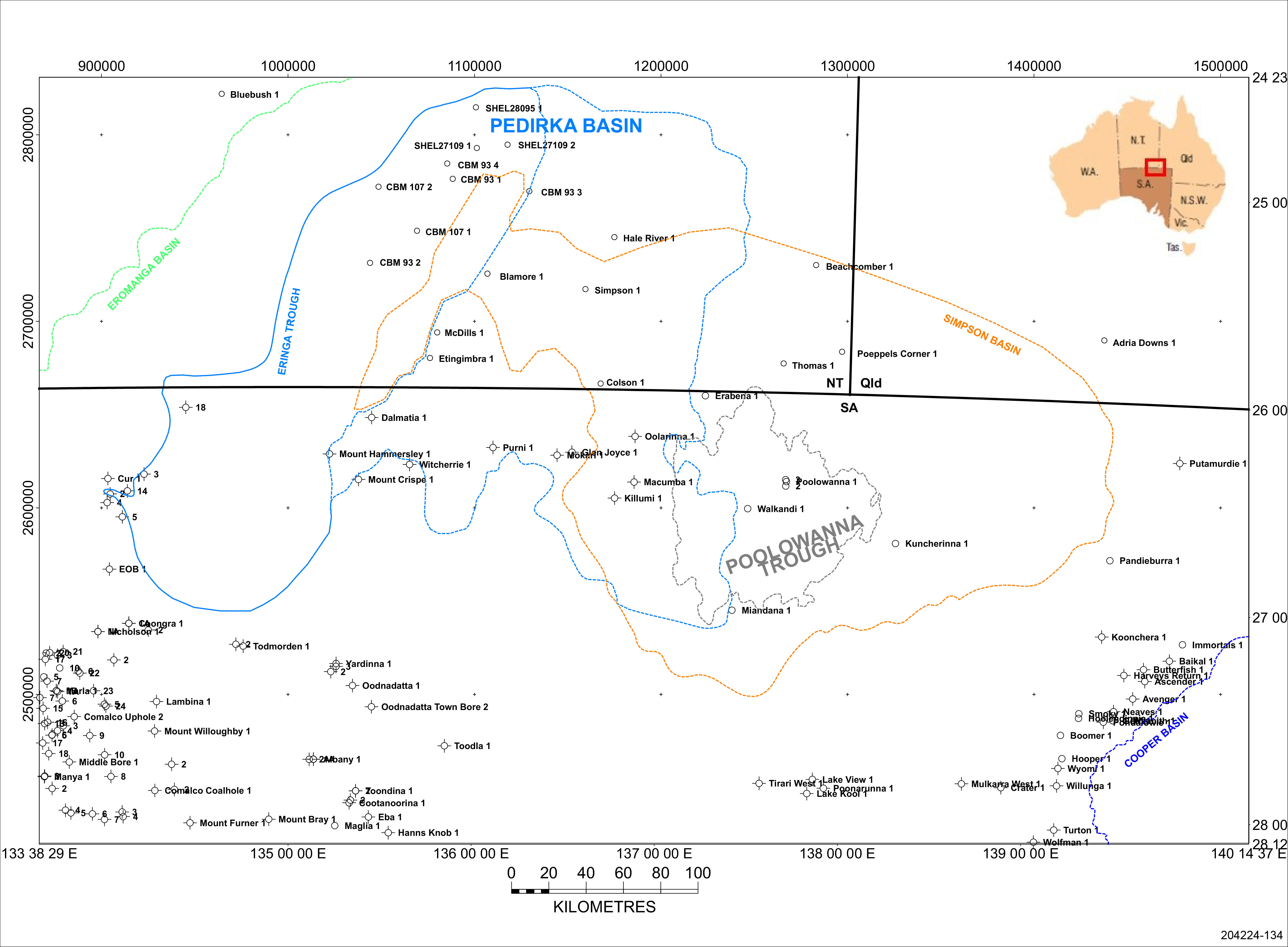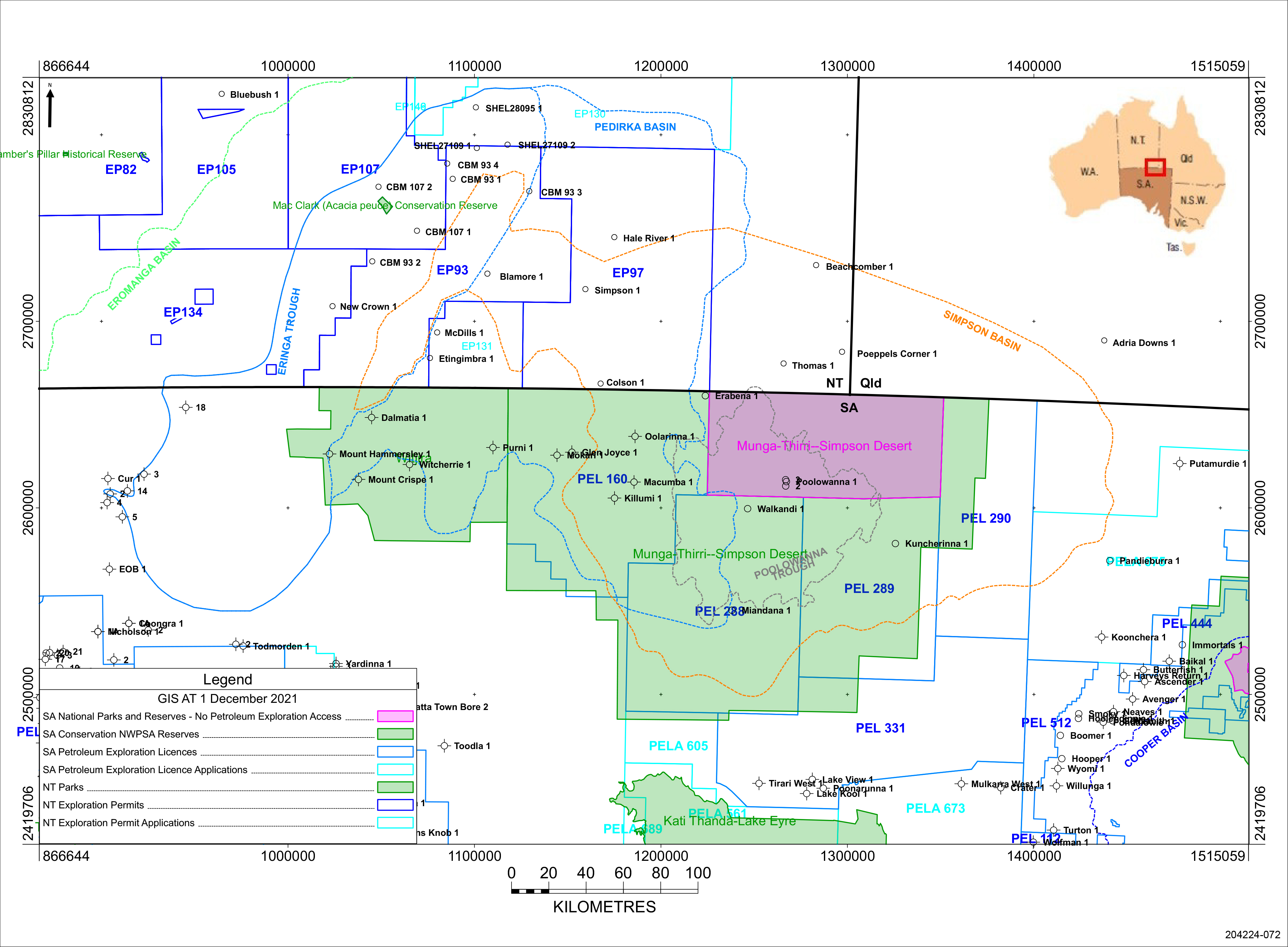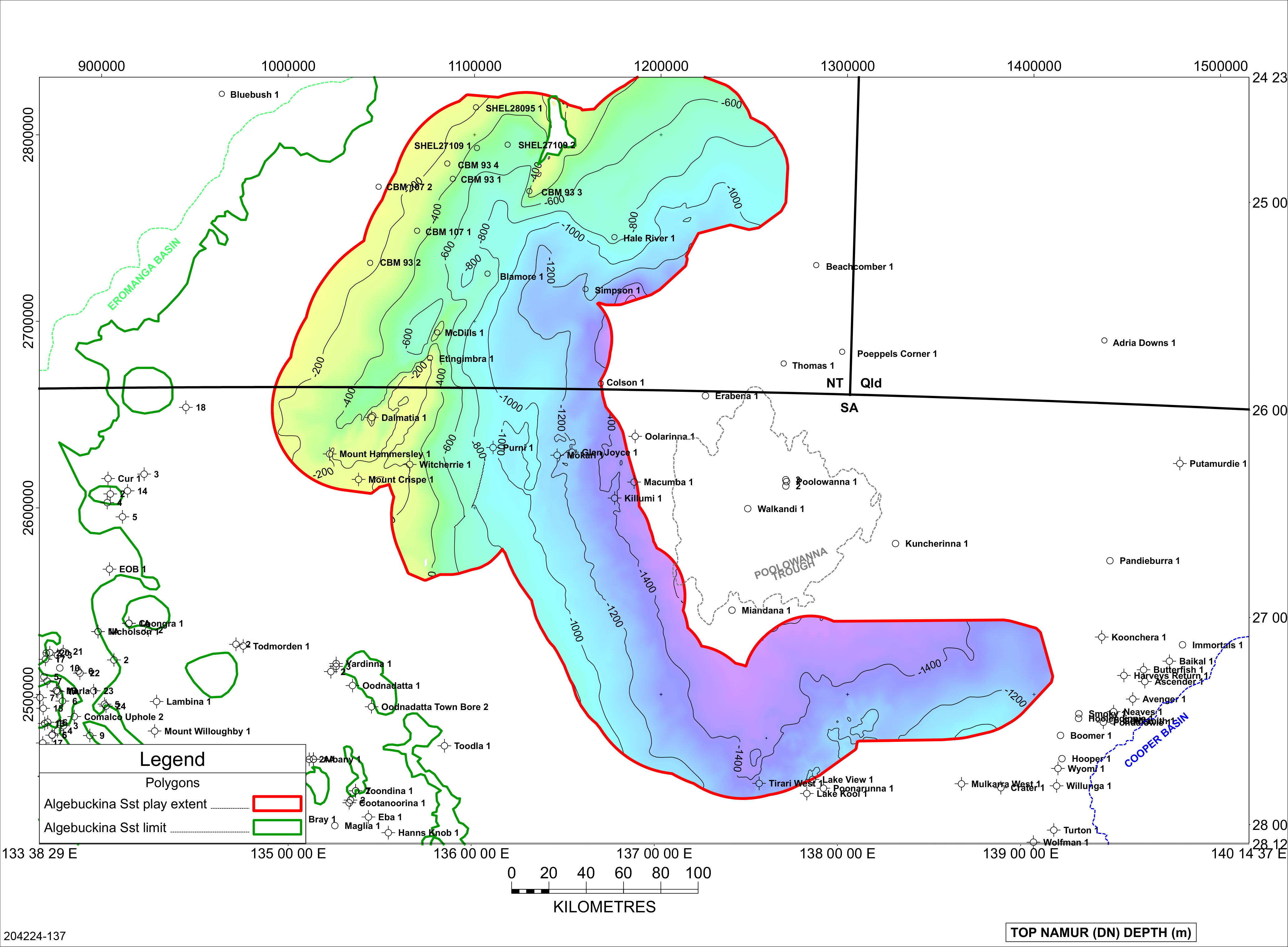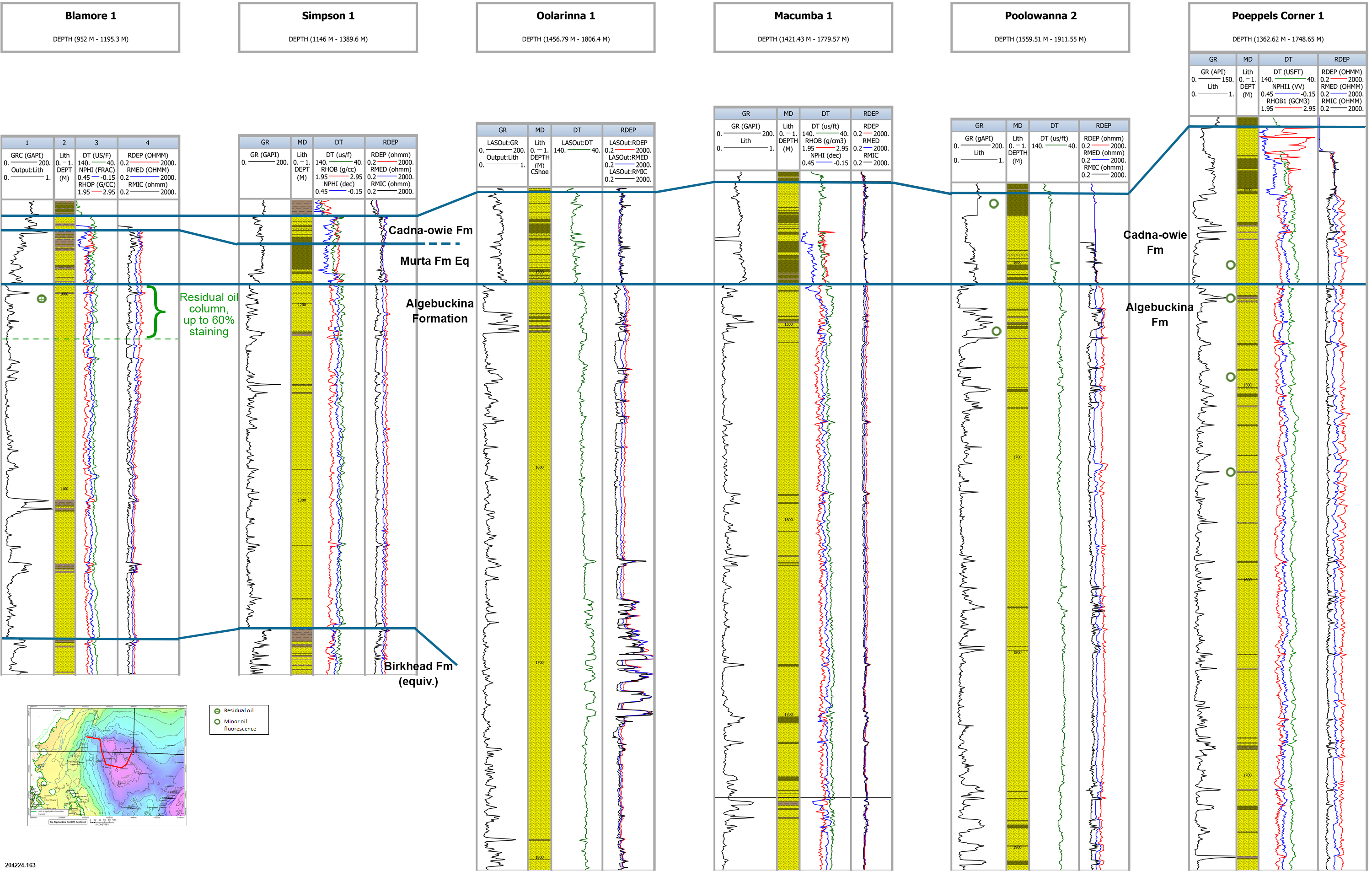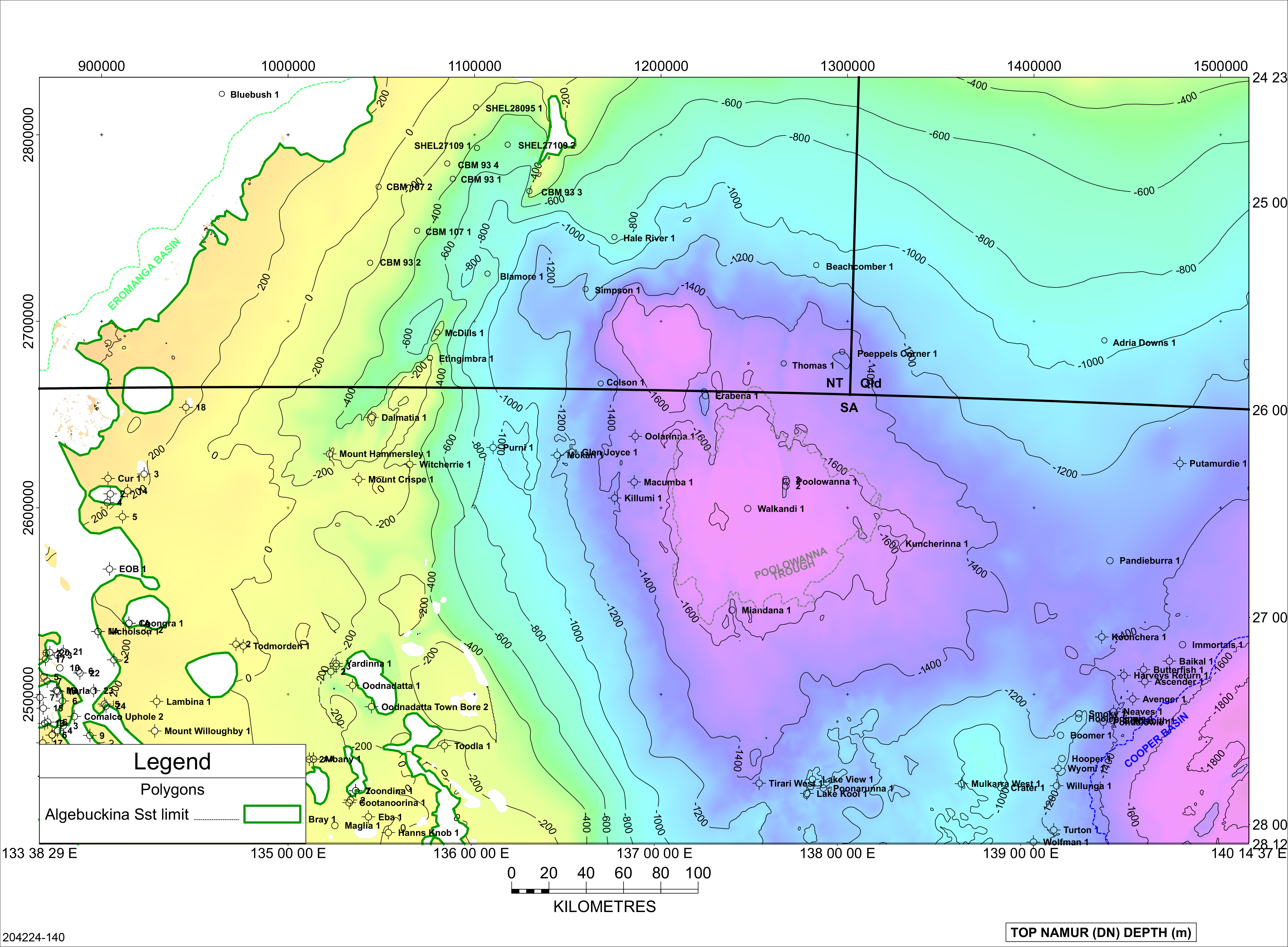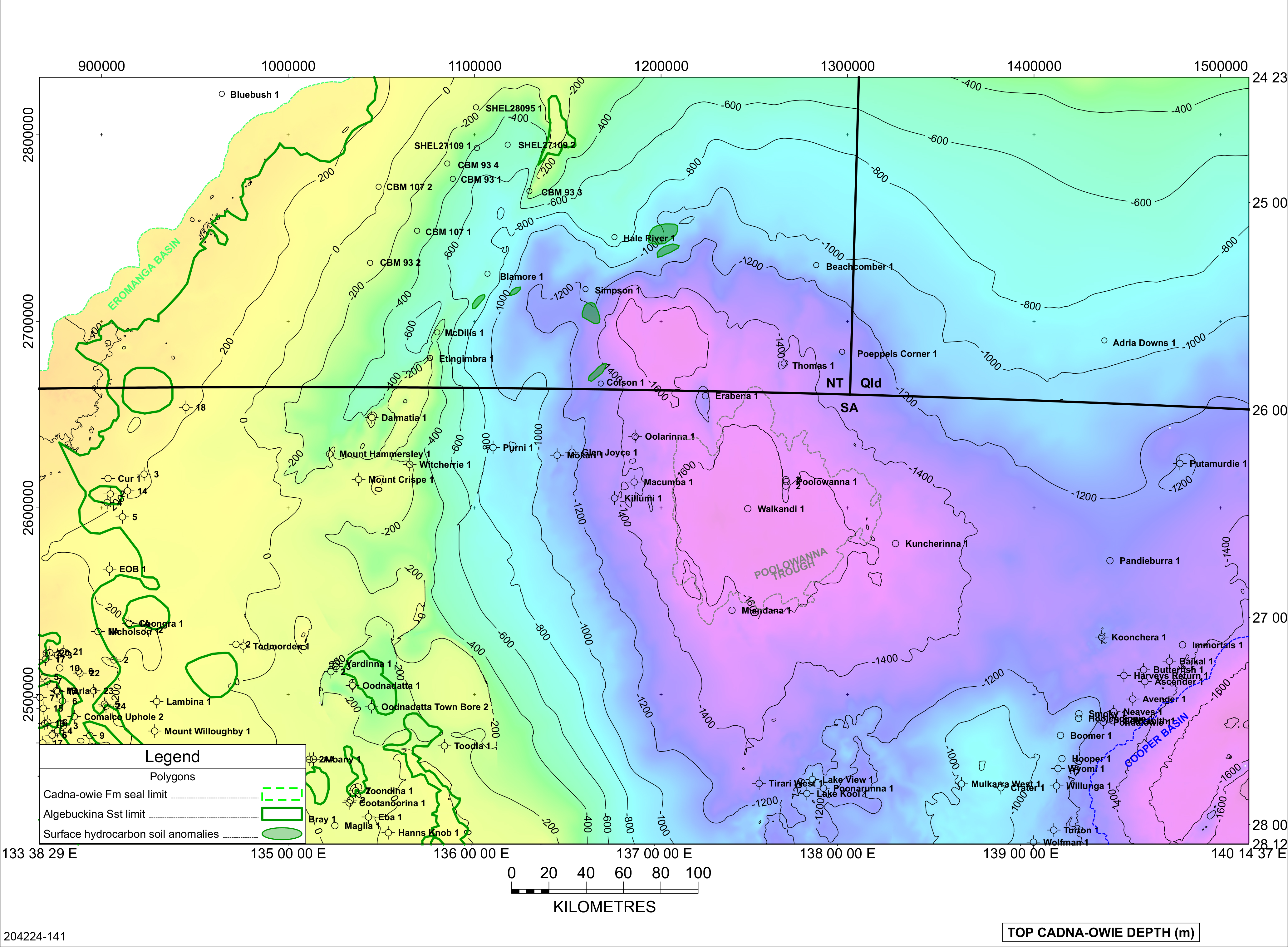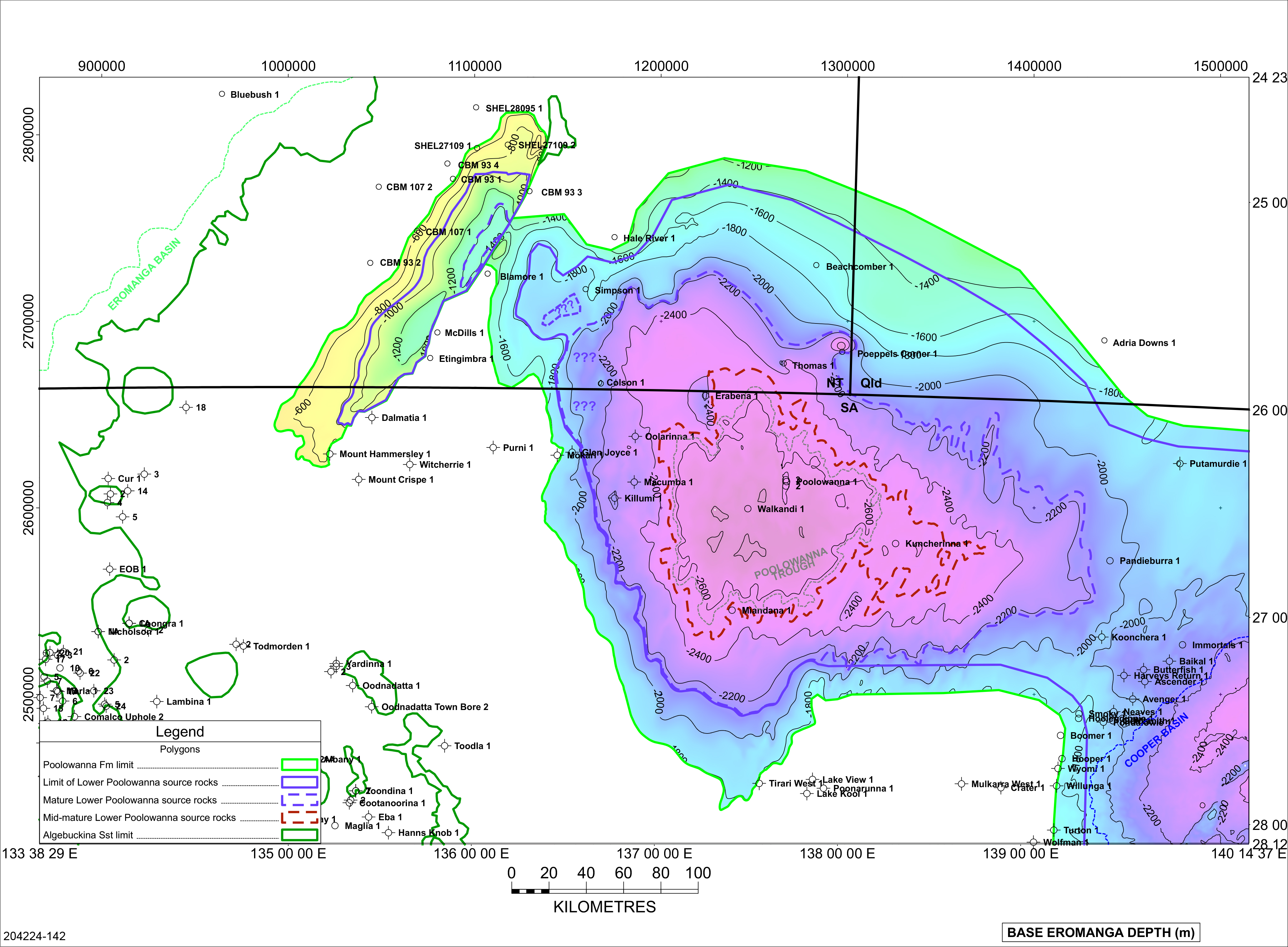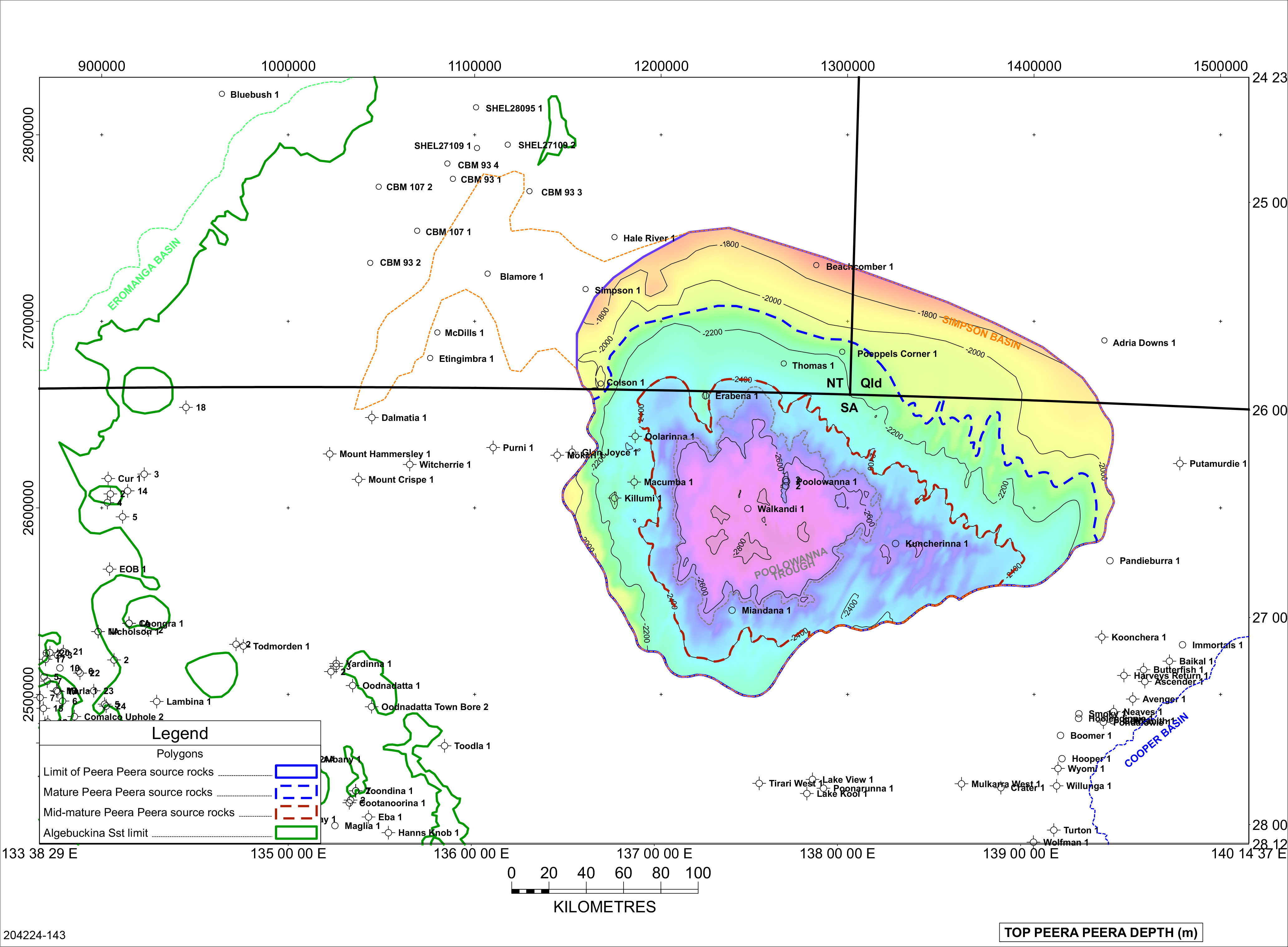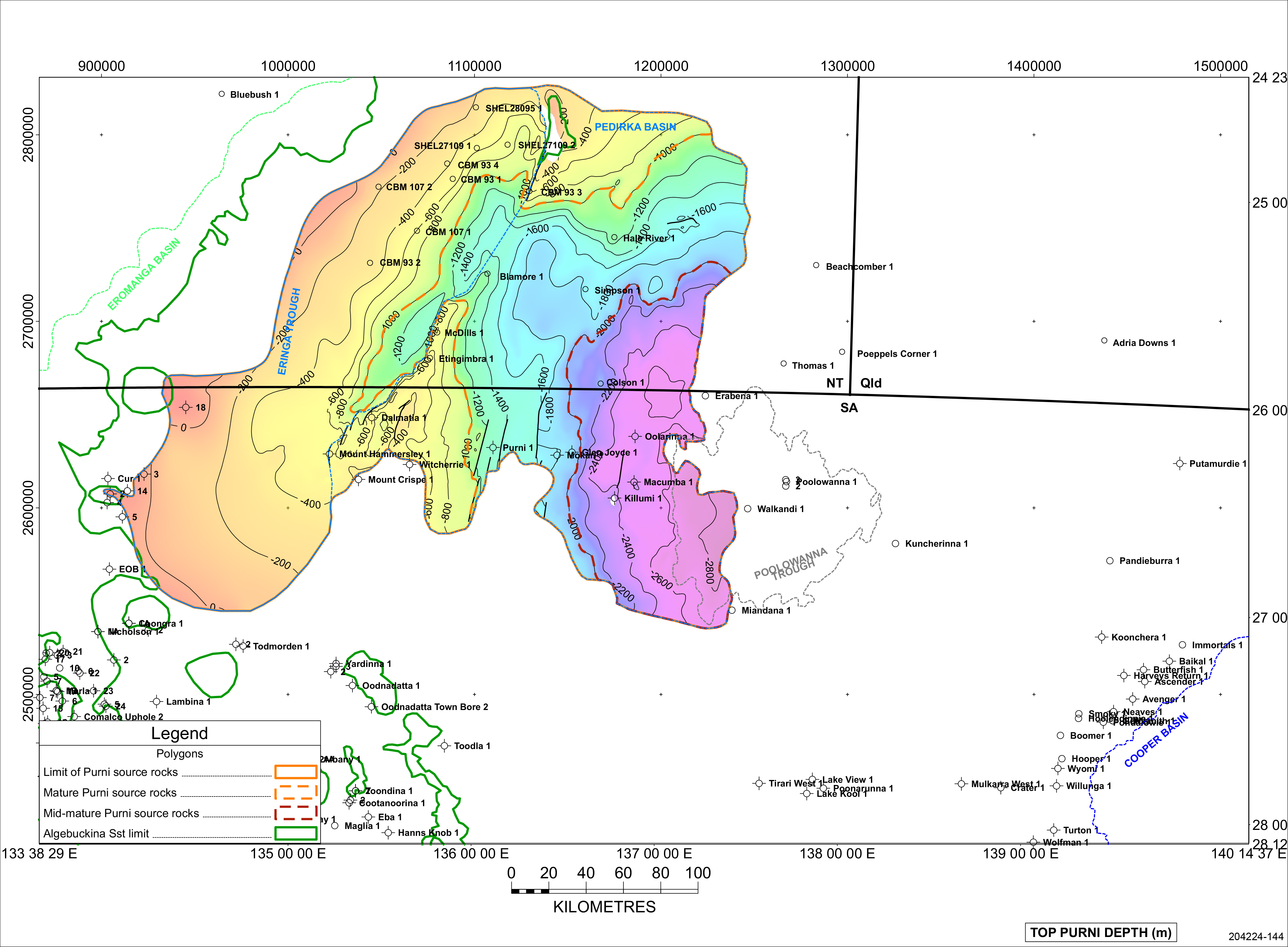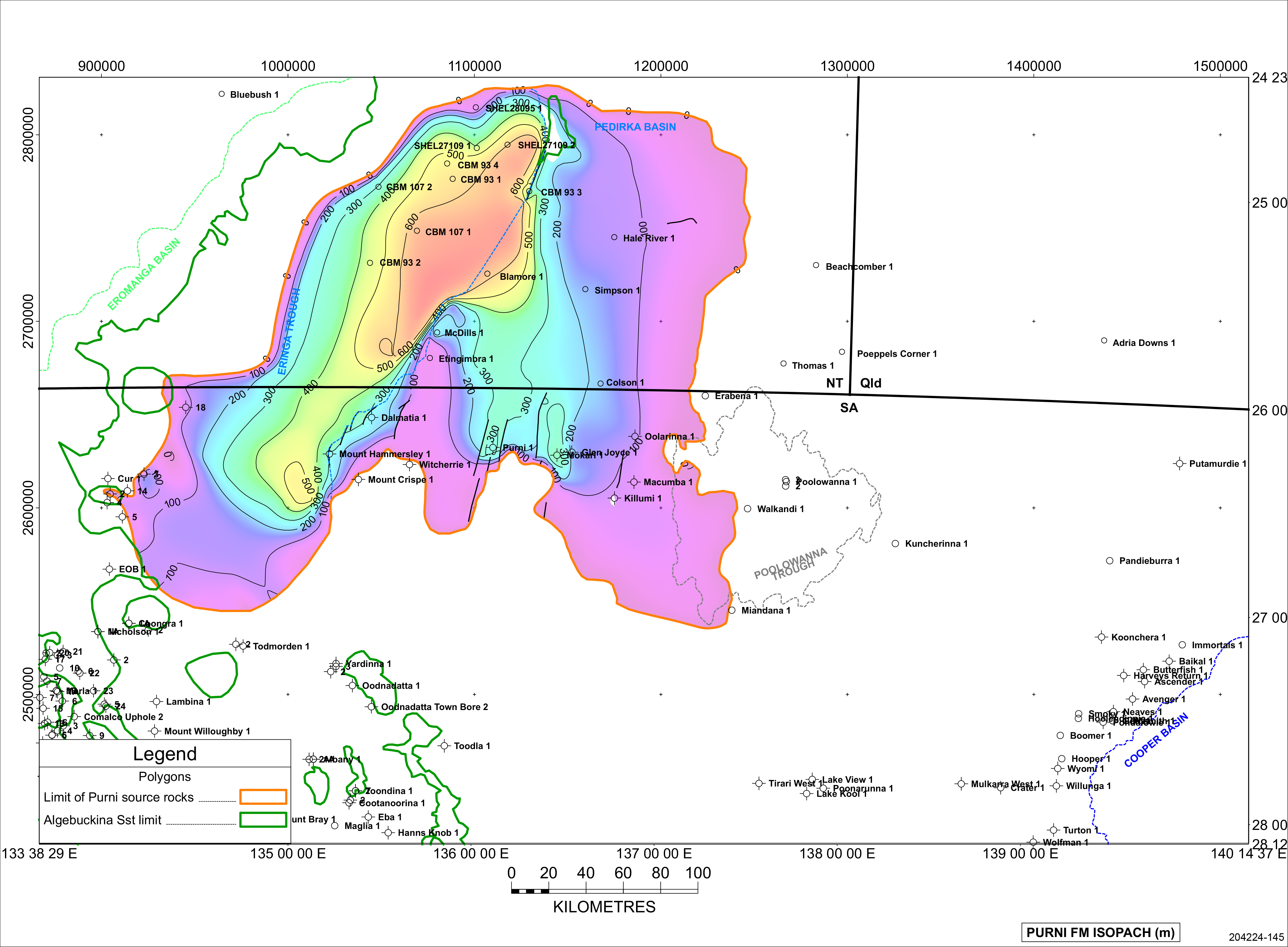Summary
| PLAY | Algebuckina Sandstone |
| SOUTH AUSTRALIA BASIN | Eromanga |
| LOCATION | Poolowanna Trough region |
| AGE | Middle-Late Jurassic |
| RESERVOIR | Algebuckina Sandstone |
| SEAL | Cadna-owie Fm./Wallumbilla Fm.–Bulldog Shale siltstones & shales |
| SOURCE ROCK/S | Lower Patchawarra Fm., Peera Peera Fm., Purni Fm. |
| HYDROCARBON PHASE | Oil |
| PRODUCTION | NONE; residual oil and oil shows in several wells |
| HYDROCARBON FLOW RATES | Water flowed at 1150BPD in Lake View 1 |
| POTENTIAL RESOURCES | ERD estimate June 2006 (Morton and Hill, 2007): 50% probability of 4.1 x 106 kL (25.8 mmbbl) in Western Eromanga Basin |
The Eromanga Basin covers around 1,000,000 km2 of central–eastern Australia, 360,000 km2 of which lies in South Australia. The Eromanga Basin encloses the multi-aquifer system of the Great Artesian Basin.
In South Australia, the Eromanga Basin overlies late Palaeozoic and older basins. It consists of a broad downwarp with two main depocentres separated by the NE-trending Birdsville Track Ridge — the Poolowanna Trough and the Cooper region — containing up to 3000m of sediment. The central Eromanga Basin is overlain by the Tertiary to Recent Lake Eyre Basin. Eromanga Basin units crop out extensively on the western and southern margins. The Poolowanna Trough in the NW of the basin in South Australia contains a thick sand-dominated sequence in comparison to the Cooper region where intercalated shale and siltstone units occur.
Early Jurassic – Late Cretaceous deposition within the Eromanga Basin was relatively continuous and widespread (Alexander et al, 2007). The two main depocentres of the Poolowanna and Patchawarra troughs were controlled by subsidence rates and plate tectonic events on the margins of the Australian Plate, with activity on the eastern Australian volcanic arc influencing sediment provenance and depositional environment. The palaeoclimate cooled progressively during the Jurassic and Cretaceous as Gondwana lay at high latitudes. Arid conditions in the Early Jurassic changed to moist cool conditions in the Late Jurassic, followed by cold conditions with periods of ice formation in the Early Cretaceous.
In the Poolowanna Trough region, the Algebuckina Sandstone ranges in age from latest Early Jurassic to Early Cretaceous, corresponding to the PJ3.2–PK1.2 palynozones, with the oldest Algebuckina outcrop being of Late Jurassic age. The formation conformably overlies and intertongues with the Poolowanna Formation at its base, and is conformably overlain by the Cadna-owie Formation as the basin was transgressed and marine conditions predominated. The lateral equivalents of the Algebuckina Sandstone in the Cooper region in chronological order of deposition are the Hutton Sandstone, Birkhead Formation, Adori Sandstone, Westbourne Formation, Namur Sandstone and Murta Formation.
The predominantly cross-bedded, sandy lithology within the Algebuckina Sandstone indicates a braided fluvial environment of deposition with minor development of meandering facies and with sands sourced from Triassic, reworked Permian and older rocks. A maximum thickness of 800m is recorded in Walkandi 1 in the Poolowanna Trough.
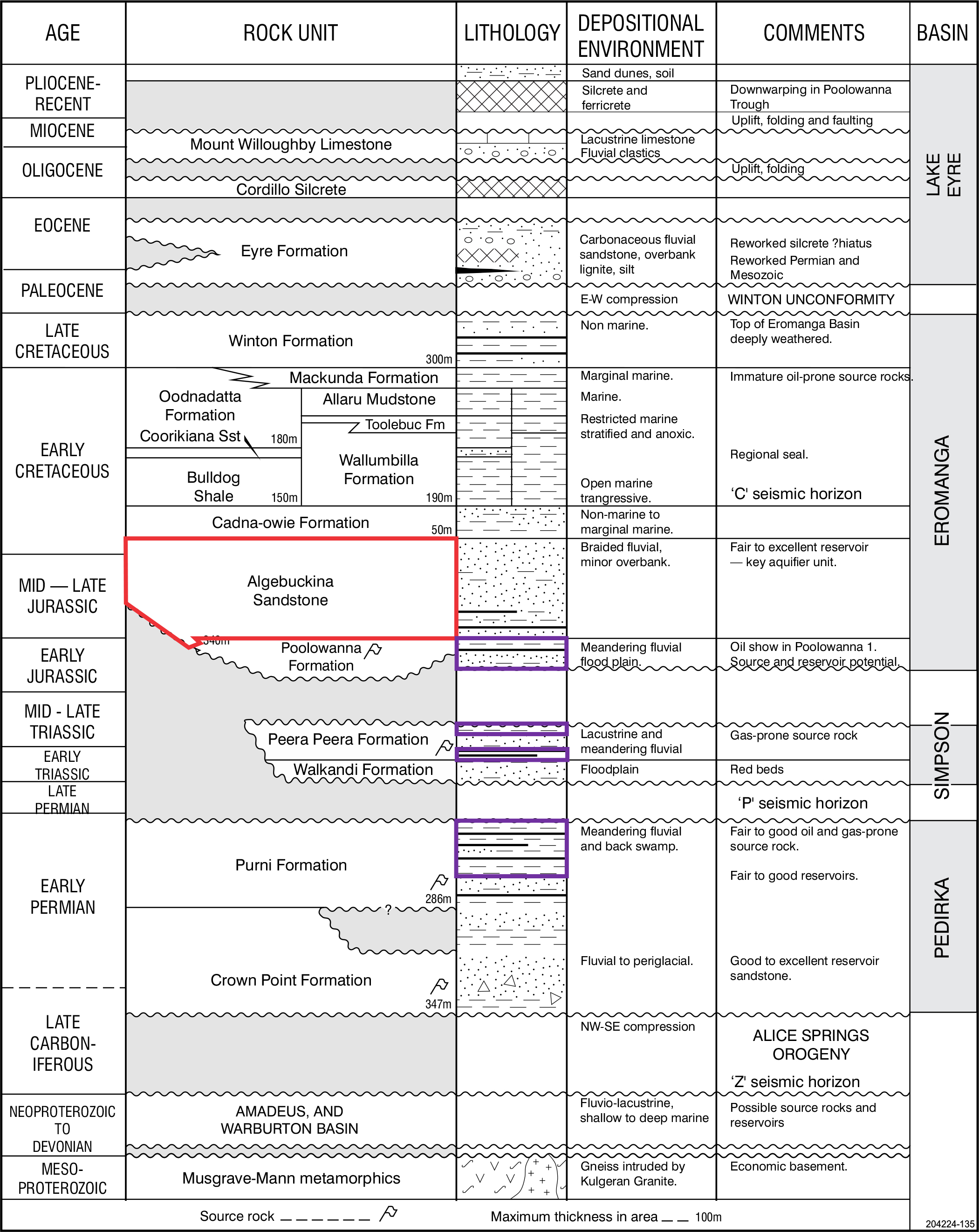
Algebuckina Sandstone highlighted in red and potential source rocks highlighted in purple. Stratigraphic column from Carne and Alexander (1997).
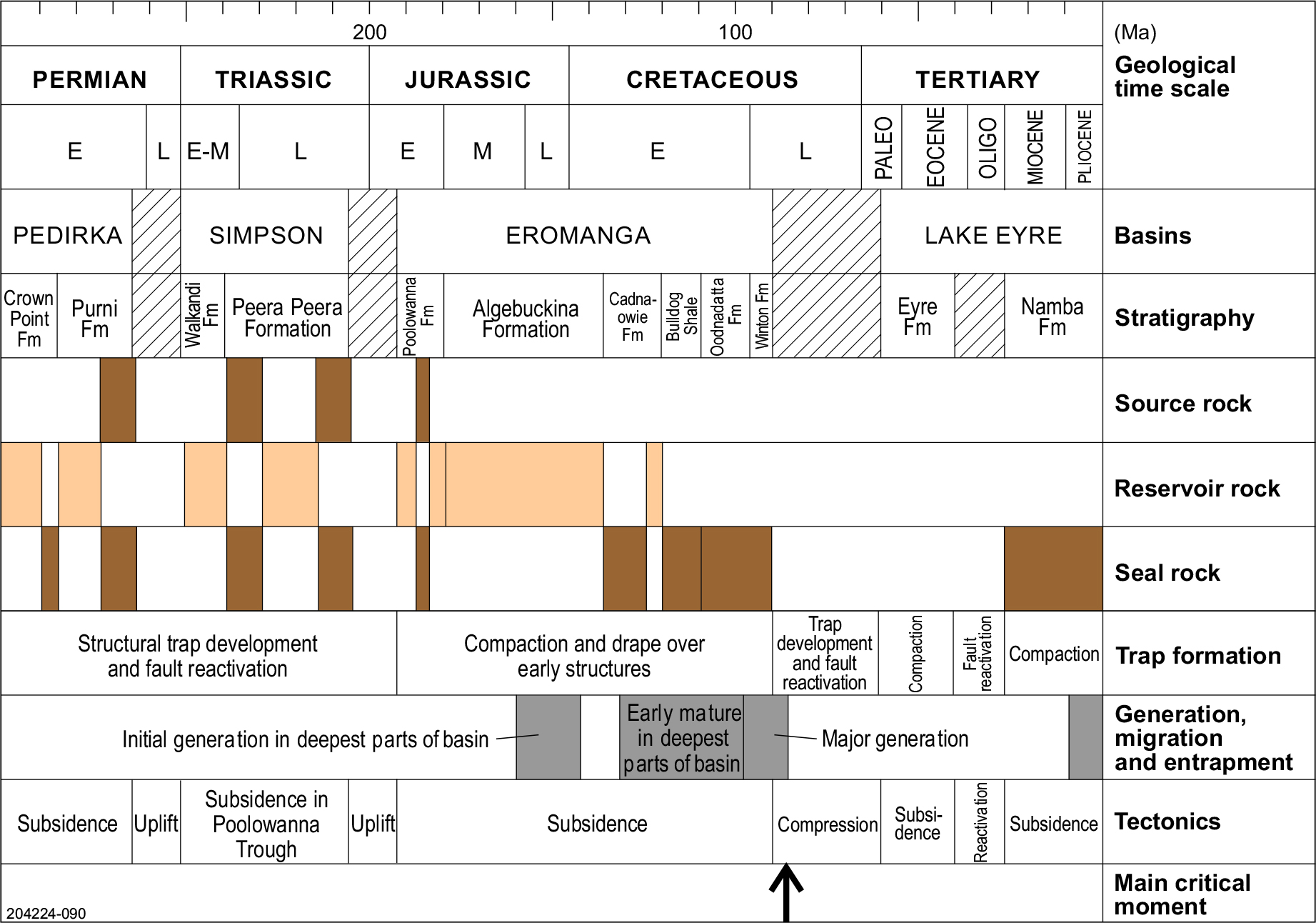
Key petroleum system events in the Pedirka Basin/Simpson Basin/Poolowanna Trough area
The key petroleum events chart for the Pedirka Basin/Simpson Basin/Poolowanna Trough area is similar to that for the Cooper-Eromanga Basins in that the critical moment was in the Late Cretaceous at the end of deposition of the Winton Formation, the last stage of the Eromanga Basin prior to uplift and erosion. Basin modelling suggests that major hydrocarbon generation and expulsion commenced around 100 Ma (Ambrose et al, 2007) and lasted around 10-15Ma, so formation of structures prior to this was critical.
Structural reactivation occurred in the Miocene, and it is likely that this breached seals for some hydrocarbon accumulations where fault seal was critical, which is likely to have been the case at Poolowanna 1. Therefore, exploration is required of more subtle structures not affected by the reactivation in the Miocene.
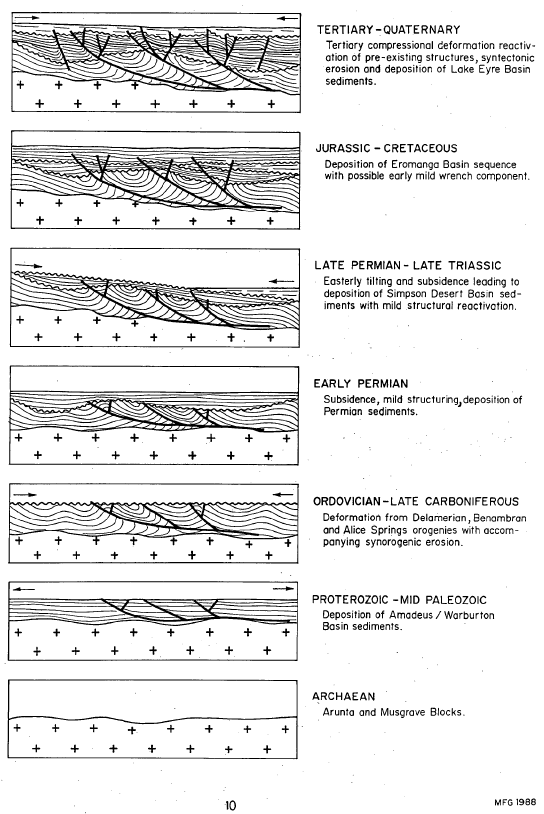
Schematic structural history of the Pedirka Basin-Poolowanna Trough area (Giuliano, 1988)
Petroleum exploration commenced in the 1950s when licences covering the Cooper and Eromanga basins were first acquired by Santos, who went against conventional wisdom that commercial accumulations of oil would not be found in Mesozoic formations within the Great Artesian Basin.
Initial exploration involved surface mapping, stratigraphic drilling, aerial surveys, gravity and aeromagnetic surveys and seismic. The first petroleum well was drilled in 1959 and Cooper Basin gas was discovered in 1963.
The first commercial hydrocarbon to flow from the Eromanga Basin was gas produced from Namur 1 in 1976 (Cooper region). Oil was discovered in 1977 with uneconomic flows of oil from basal Jurassic and Triassic sediments in Poolowanna 1 in the Poolowanna Trough. The first economic oil flow was recorded from Strzelecki 3 (Cooper region) in the following year and this stimulated a major oil exploration program.
Exploration activity intensified in the Poolowanna Trough/Pedirka Basin area in the 1980s in response to the Poolowanna discovery. Six seismic surveys were carried out and five wells were drilled, three in 1985 and two in 1988.
Seismic reinterpretation by Santos indicated that five of the previously drilled wells were not valid structural tests being outside closure at all objectives. Of the 1985 wells, Oolarinna 1 had no independent fault closure and Glen Joyce 1 had little closure.
It should be noted that no wells have been drilled in the South Australian sector since the 1980s, although Central Petroleum drilled Blamore 1 and Simpson 1 in the Northern Territory in 2008. Exploration in the area would benefit from current ideas on the geology of the petroleum systems in the Cooper Basin region and modern technology and interpretation techniques.
Hydrocarbon shows have been recorded in most wells within the Poolowanna Trough region, including within the Algebuckina Sandstone. However, oil and gas has been recovered from only 2 wells, the Poolowanna and Peera Peera Formations in Poolowanna 1, and the Poolowanna Formation in Poolowanna 3.
The classification scheme used by Geoscience Australia has been used to determine the type of show present in a formation.
Hydrocarbon shows and flow rates in South Australian wells in the Poolowanna Trough/Simpson Basin/Pedirka Basin region:
| Well | Year/Result | Formation | Shows/Recovery | Flow rate |
|---|---|---|---|---|
| Pandieburra 1 |
1963 Oil shows | Peera Peera (?) | Minor fluorescence | |
| Dullingari Group | Minor fluorescence. Recovered 190ft mud-cut water with a trace of hydrocarbons. | |||
| Mokari 1 |
1966 Dry hole | Poolowanna | Gas show; mudlog gas 14 times background. Minor fluorescence. Water to surface (WTS) in 12 mins. | 387 cu ft/hr = rate of 1,654BWPD |
| Purni | Minor fluorescence. WTS in 17 mins. | Reported rate of 387 cu ft/hr | ||
| Poolowanna 1 |
1977 Oil shows | Poolowanna | Gas to surface (GTS) in 125 mins. Oil and water to surface in 3hrs 55 mins. Recovered 71¼ barrels water and 9½ barrels oil, 36.9o API gravity, with pour point of 41o C. | Gas at rate too small to measure (RTSTM). Calculated flow rate of 96BOPD |
| Peera Peera | Oil show. GTS in 120mins. Recovered 110ft mud and condensate. | Gas at RTSTM | ||
| Walkandi 1 |
1981 Oil shows | Poolowanna | Oil shows. Recovered 650ft muddy water and 1450ft gas-cut slightly muddy water. | |
| Peera Peera | Oil shows. Recovered 46ft rat hole mud and 31ft slightly gas-cut mud. | |||
| Walkandi | Oil shows. Recovered 480ft water cushion and 4900ft slightly gas-cut mud. | |||
| Erabena 1 |
1981 Oil shows | Poolowanna | Minor fluorescence | |
| Peera Peera | Minor fluorescence | |||
| Kuncherinna 1 |
1981/2 Oil shows | Poolowanna | Recovered 90ft rathole mud with trace of oil | |
| Peera Peera | Minor fluorescence | |||
| Poolowanna 2 |
1985 Oil shows | Wallumbilla | Minor fluorescence | |
| Cadna-owie | Minor fluorescence | |||
| Algebuckina | Minor fluorescence | |||
| Poolowanna | Minor fluorescence. Recovered 1026ft VSGCMW, 306ft SGCM. | |||
| Peera Peera | Minor fluorescence. Recovered 240ft very slightly gas-cut muddy water. | |||
| Oolarinna 1 |
1985 Dry hole | Poolowanna | Minor fluorescence | |
| Peera Peera | Recovered 5310ft gas-cut water (slightly muddy at top) | |||
| Killumi 1 |
1985 Dry hole | Poolowanna | Minor fluorescence | |
| Miandana 1 |
1985 Oil shows | Poolowanna | Minor fluorescence | |
| Poolowanna 3 |
1989 Oil shows | Algebuckina | Minor fluorescence | |
| Poolowanna | Minor fluorescence. GTS in 141 mins. Recovered 5550ft slightly oil and gas-cut water and 2290ft water in 171 mins. | Gas at RTSTM. 80BWPD. | ||
| Peera Peera | Minor fluorescence |
Hydrocarbon shows in Northern Territory wells in the Poolowanna Trough/Simpson Basin/Pedirka Basin region:
| Well | Year/Result | Formation | Shows/Recovery |
|---|---|---|---|
| McDills 1 | 1965 Trace hydrocarbon indication | Purni | Minor fluorescence |
| Colson 1 | 1978 Trace hydrocarbon indication | Poolowanna | Minor fluorescence |
| Peera Peera | Minor fluorescence | ||
| Warburton | Log interpretation “oil show” | ||
| Thomas 1 | 1981 Oil indication | Poolowanna | Residual oil. Recovered 4951ft water with minor mud in 68 mins. |
| Poeppels Corner 1 | 1984 Trace hydrocarbon indication | Algebuckina | Minor fluorescence |
| Poolowanna | Minor fluorescence | ||
| Peera Peera | Minor fluorescence | ||
| Beachcomber 1 | 1988 Trace hydrocarbon indication | Cadna-owie | Minor fluorescence in coals |
| Algebuckina | Minor fluorescence in coals | ||
| Peera Peera | Minor fluorescence in coals | ||
| Blamore 1 | 2008 Oil and gas show | Algebuckina | Residual oil |
| Walkandi | Minor fluorescence | ||
| Purni | Gas shows in coals. Trace fluorescence. | ||
| CBM 93 1 | 2008 Trace hydrocarbon indication | Purni | Minor fluorescence |
| Simpson 1 | 2008 Trace hydrocarbon indication | Poolowanna | Minor fluorescence |
| Walkandi | Minor fluorescence |
Petroleum exploration permits, regional reserves and conservation parks in the Poolowanna Trough region as at December 2021
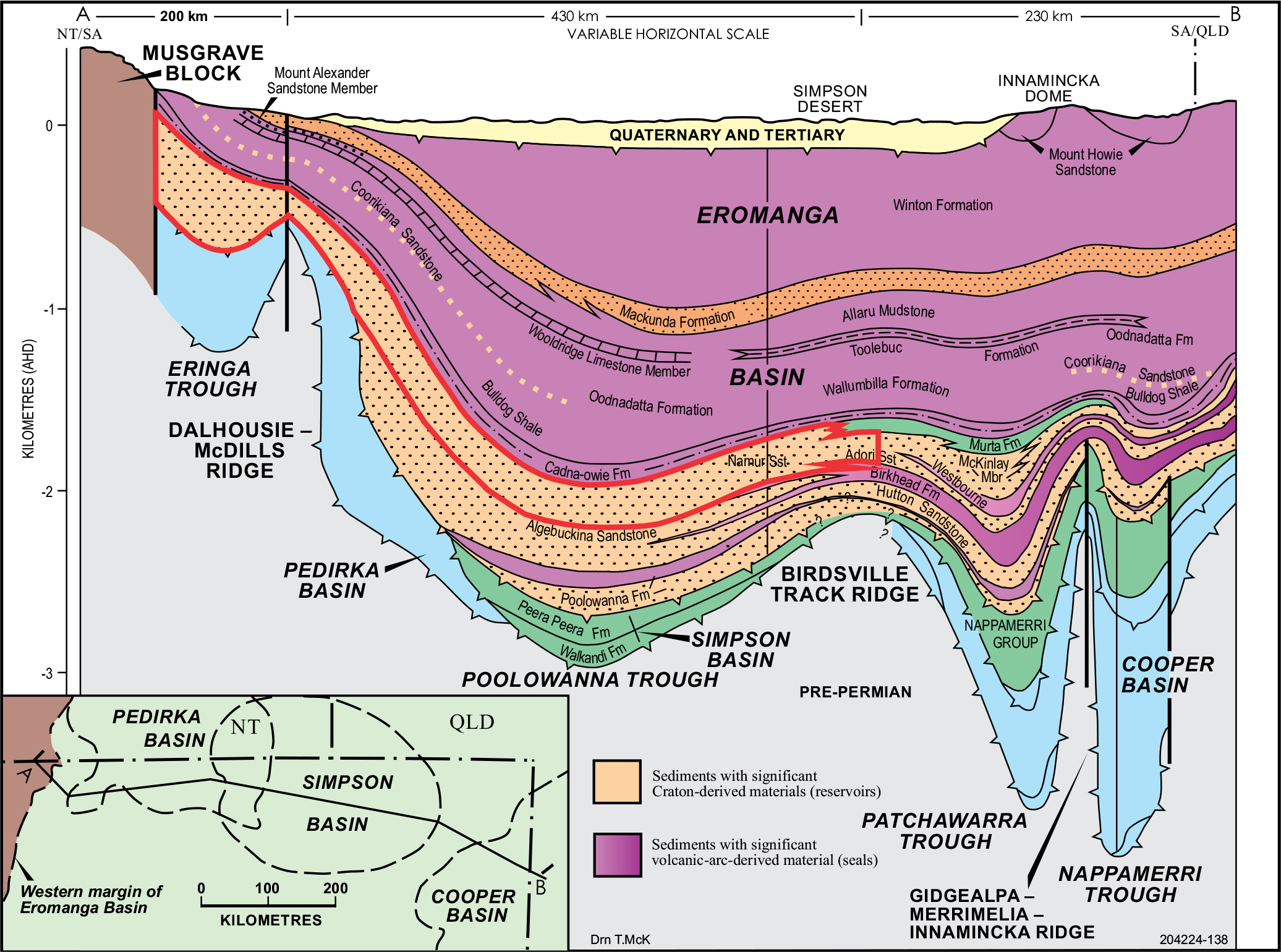
Algebuckina Fm in the Poolowanna Trough region highlighted in red
Blamore 1 (2008)
No type well for the Algebuckina Sandstone has been assigned in South Australia. However, Alexander et al (2007) indicated that the type locality is a “low escarpment south and west of Algebuckina Hill, 0.5 miles [0.8 km] SW of the unused Algebuckina siding on the Central Australian Railway line”, approximately 50km SW of Oodnadatta, South Australia. A reference section was also designated from outcrop near Mt Anna, around 65km ENE of Coober Pedy.
For this study Blamore 1 (2008) has been assigned as the type well as it has contained the best oil shows to date in the Poolowanna Trough region.
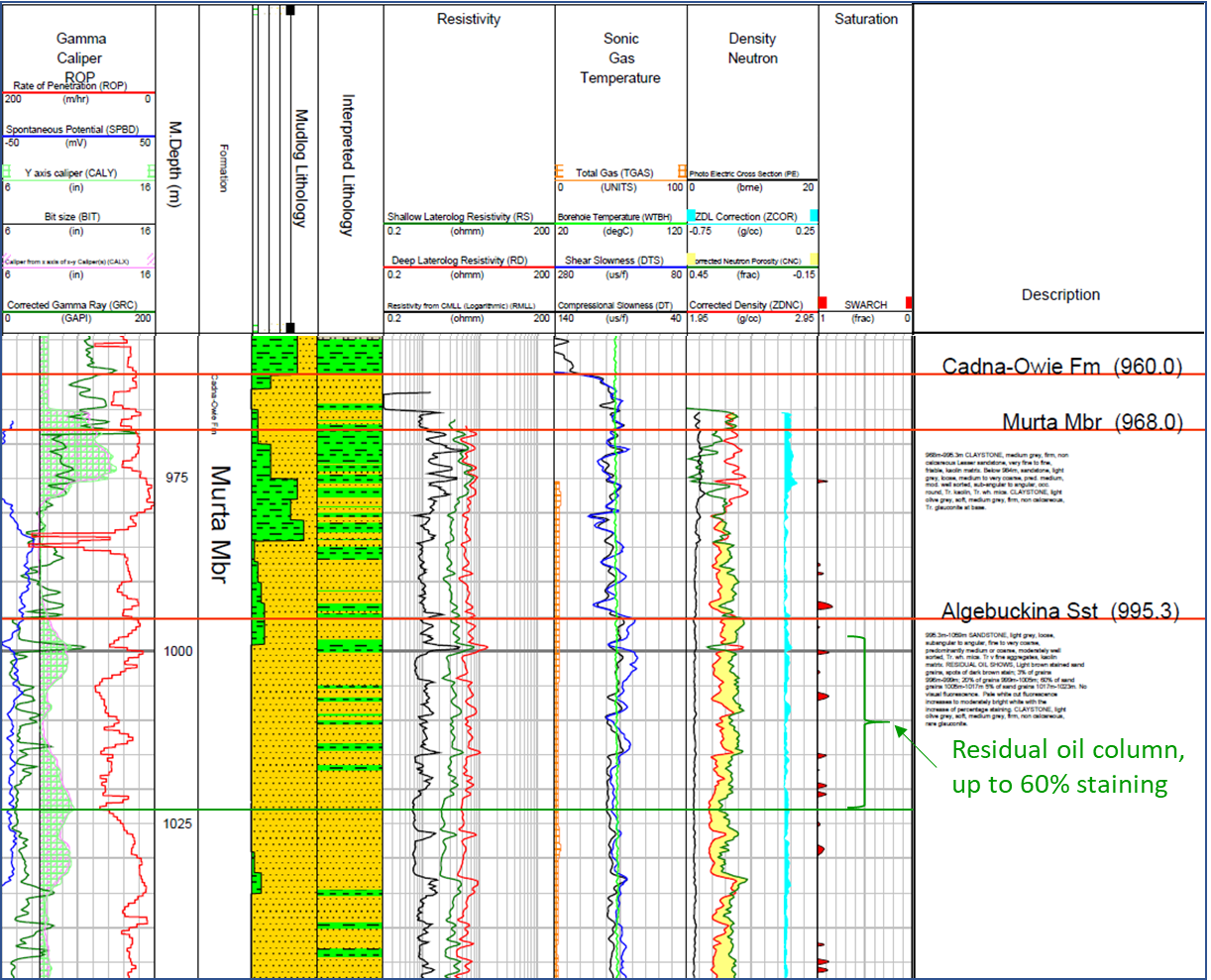
Uppermost Algebuckina Sandstone in Blamore 1 (excerpt from Composite Log)
The Blamore 1 Well Completion Report (WCR) stated that ”a positive indication of prior oil entrapment was seen with the intersection of a 15m plus residual oil column from 998m – 1023m (up to 60% staining) at the top of the Algebuckina Sandstone. … The shows were not accompanied by elevated gas readings … Slow developing cut fluorescence, pale white in 999m to 1005m interval, increasing to pale to moderately bright white cut fluorescence 1005m to 1017m interval. All samples consisted of mainly loose sand.”
No tests were conducted.
Analogue: Bauer Field, South Australian Cooper Basin area of the Eromanga Basin
To the end of April 2021, the Bauer Field on the western flank of the Cooper Basin area had produced 20.233 million barrels of oil from the Namur Sandstone, equivalent to the uppermost Algebuckina-Sandstone.
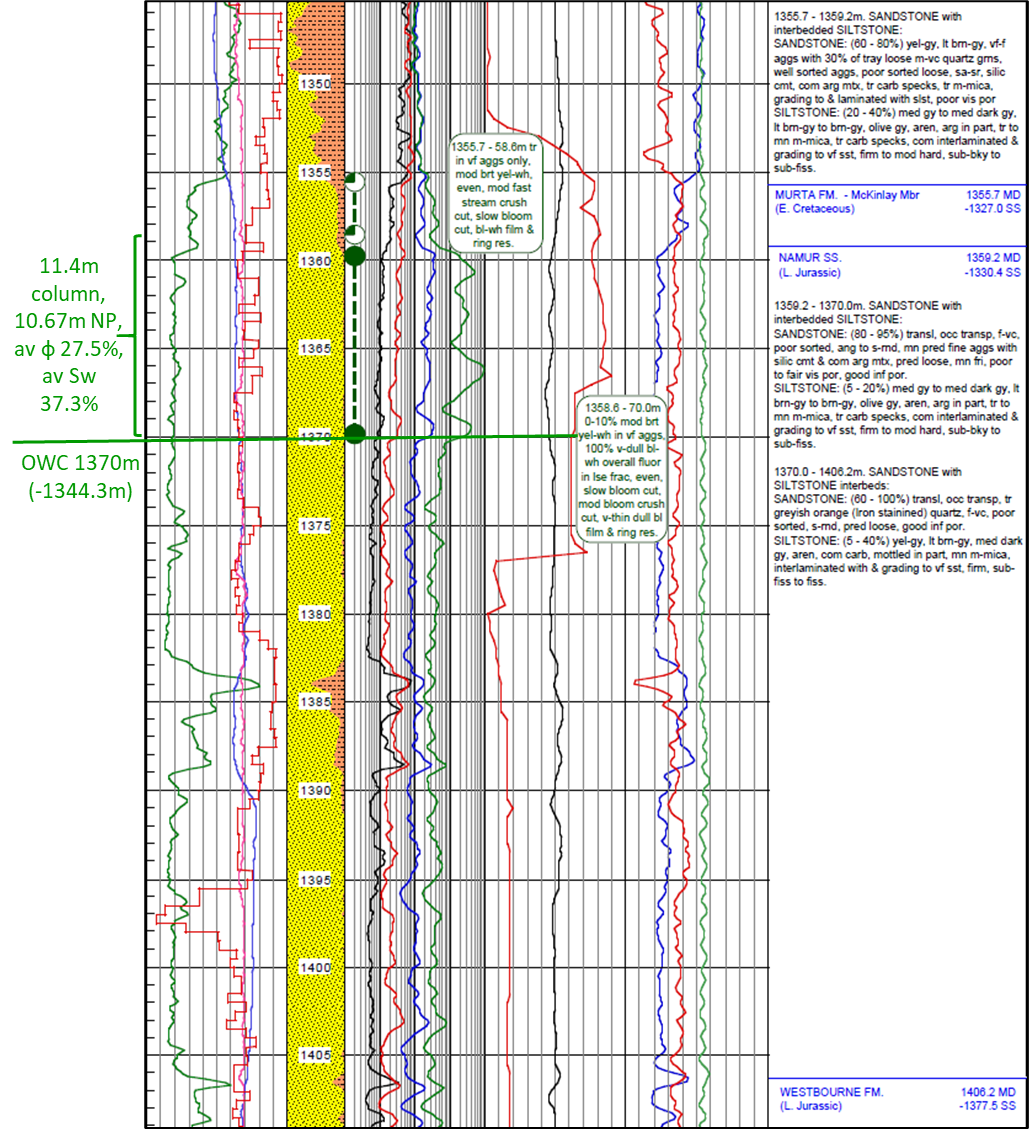
Namur Sandstone that has produced 1.279mmbo in Bauer 1, South Australian Cooper Basin area (excerpt from Composite Log)
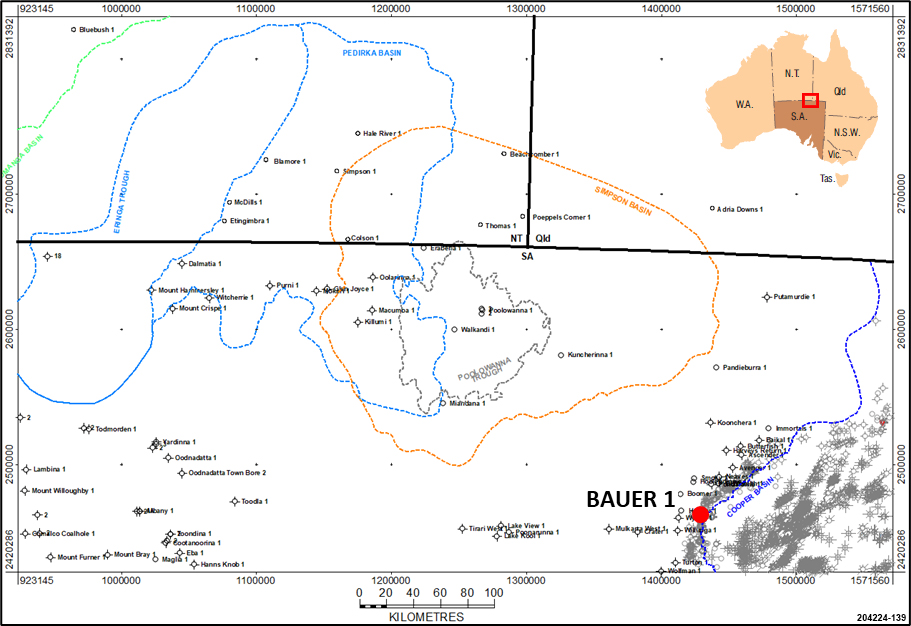
Location of Bauer 1 with respect to the Poolowanna Trough
The Blamore 1 WCR described the Algebuckina as “light grey sandstone, consisting of loose generally subangular to angular quartz grains, rarely rounded, fine to very coarse grained, predominantly medium or coarse moderately well sorted above 1053m; below this depth grain size was fine to coarse, commonly medium, well sorted. Medium to coarse sized transparent muscovite mica flakes are rare to common throughout. … Occasional thin claystone beds are present in the sequence and are generally light olive grey, soft, slightly carbonaceous; occasionally white grey, soft with abundant kaolin clay. Below 1125m thin coaly laminae and rare to trace coal, dull black, rarely brittle angular fragments are present with the thin claystone beds.”
Alexander et al (2007) described the Algebuckina Sandstone regionally as a white, fine to coarse-grained quartzose sandstone with granule and pebble layers and shale intraclasts common in coarser beds. Minor lenses of siltstone and shale are locally developed. A maximum thickness of 800m is recorded in Walkandi 1 in the Poolowanna Trough. Facies within the Algebuckina Sandstone in the central part of the basin are identical to those of the Hutton and Namur sandstones. The predominantly cross-bedded, sandy lithology indicates a braided fluvial environment of deposition with minor development of meandering facies and with sands sourced from Triassic, reworked Permian and older rocks.
The formation conformably overlies and intertongues with the Poolowanna Formation at its base and is conformably overlain by the Cadna-owie Formation as the basin was transgressed and marine conditions predominated. The lateral equivalents of the Algebuckina Sandstone in the Cooper region in chronological order of deposition are the Hutton Sandstone, Birkhead Formation, Adori Sandstone, Westbourne Formation and Namur Sandstone. In general the Algebuckina doesn’t contain the same level of fine grained material which helps define the different formations in the Cooper region, and so the top of the Algebuckina should be regarded as the main target for potential hydrocarbon accumulations within the formation.
The predominantly cross-bedded, sandy lithology within the Algebuckina Sandstone indicates a braided fluvial environment of deposition with minor development of meandering facies and with sands sourced from Triassic, reworked Permian and older rocks. A maximum thickness of 800m is recorded in Walkandi 1 in the Poolowanna Trough.
The Algebuckina Sandstone has good to excellent porosity and permeability and forms a major artesian aquifer. Carne & Alexander (1997) reported that few laboratory measurements were available, but log-derived porosities averaged >20% and that aquifer flow rates were of the order of 500–1000 kL/d (3145-6290BWPD). The Blamore 1 WCR stated that the formation is highly porous, with 247m consisting of net reservoir possessing an average porosity of 26% from petrophysical evaluation.
A DST was conducted in Lake View 1 (1988), drilled to the south of the Poolowanna Trough on the edge of the approximate Algebuckina Sandstone play extent interpreted in this study, on the basis of some minor petrophysical anomalies flowed water on DST at 1150BPD in the Namur Sandstone, the equivalent of the uppermost Algebuckina. Lake Kool 1 (1997) drilled approximately 8km SW of Lake View 1 also flowed water on test from the Namur Sandstone, at 815BPD, with no trace of hydrocarbons.
Cores have been cut in the Algebuckina Sandstone in only 3 wells in the region:
Poolowanna 1 (1977) in the Poolowanna Trough
- A core was cut towards the bottom of the Algebuckina section, so may not be representative of the top of the formation. No shows were recorded in the interval. No photographs of the core have been taken.
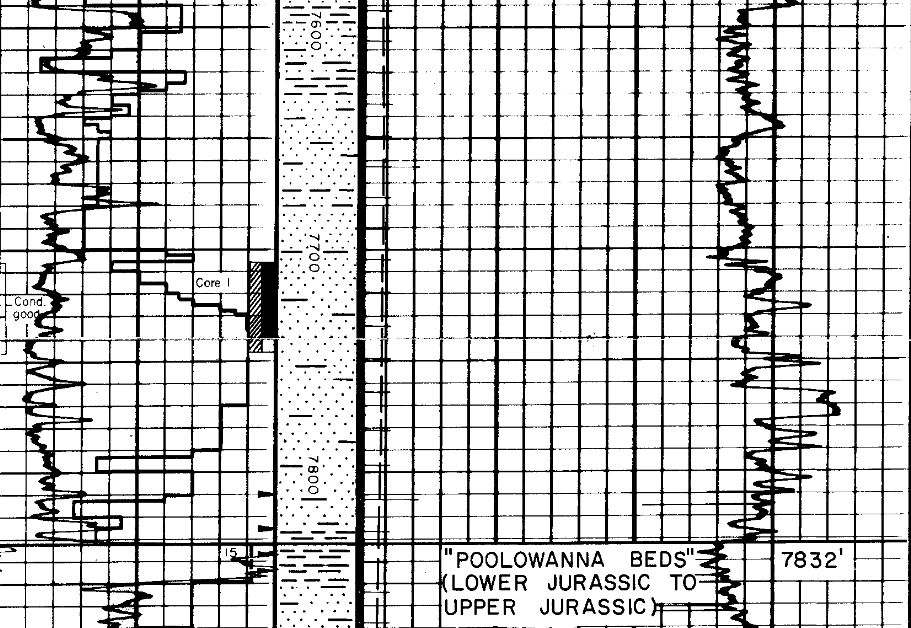
Core 1 in the lowermost Algebuckina Sandstone in Poolowanna 1 (excerpt from Well Completion Report)
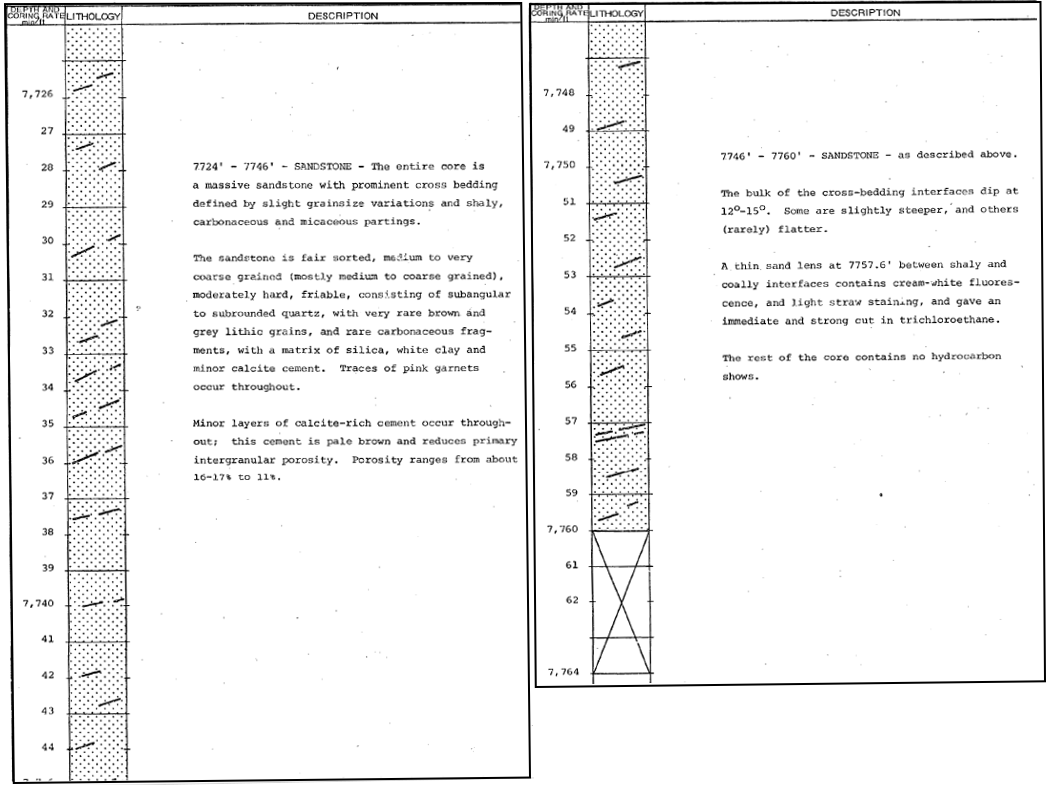
Description of core 1 in the lowermost Algebuckina Sandstone in Poolowanna 1 (excerpt from Well Completion Report)
Lambina 1 (1969) in the Arkaringa Basin to the SW of the Poolowanna Trough
- A core was cut in the Algebuckina Sandstone although no core was recovered due to very poorly consolidated sandstone falling out of the core barrel; lack of cement could be due to the shallow depth, 736ft to 746ft MD (224.3m to 227.3m)
Manya 3 (1980/81) in the Officer Basin to the WSW of the Poolowanna Trough
- Only 2.01m of core was cut at 15m depth
- No description is available in the Well Completion Report
- One core photograph is available via the DEM PEPS database:
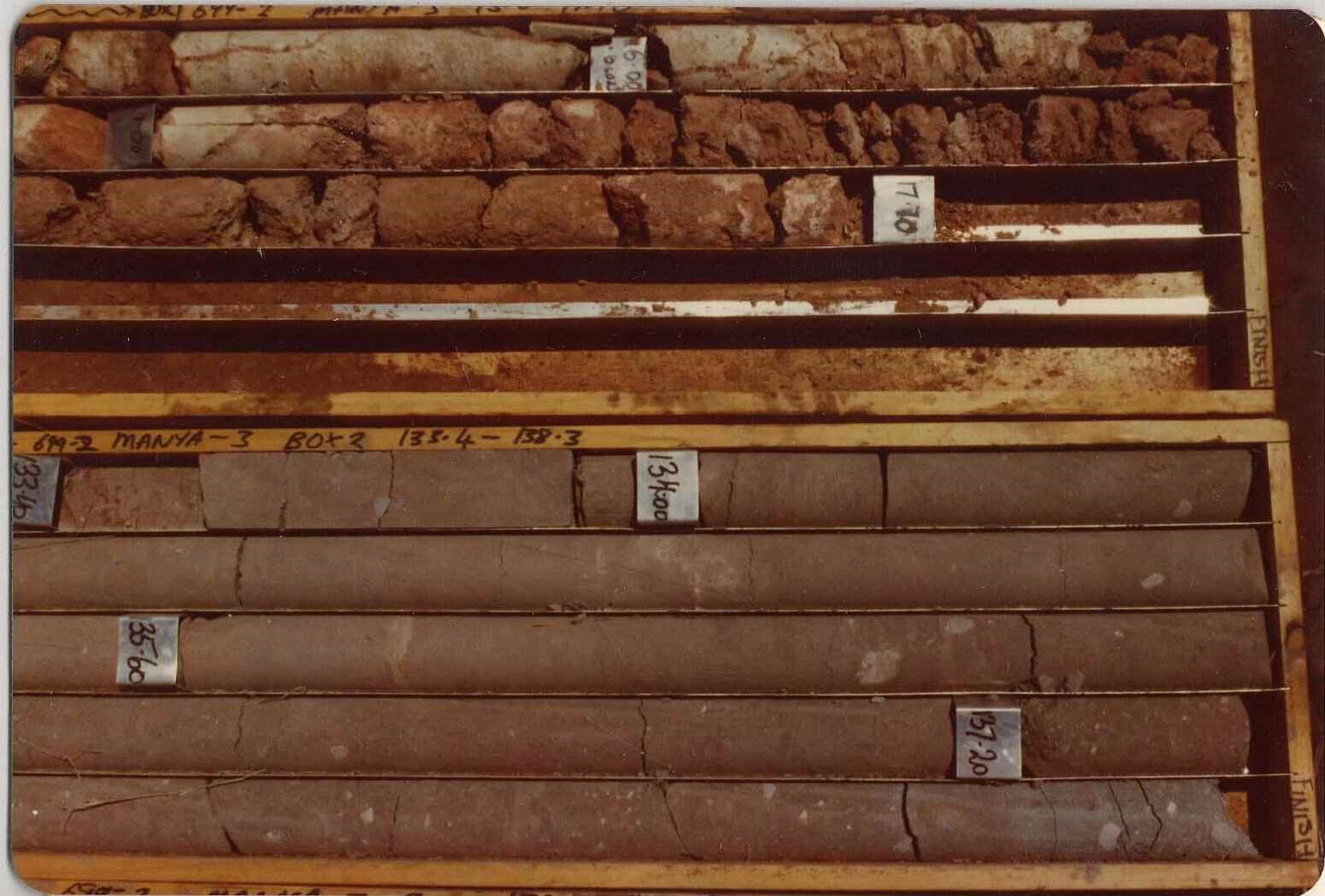
Core photograph of Manya 3
For this study Blamore 1 (2008) has been assigned as the type well as it has contained the best oil shows to date in the Poolowanna Trough region. The Well Completion Report for the well stated the following:
- No live oil was found in Blamore No.1 but a positive indication of prior oil entrapment was seen with the intersection of a 15m plus residual oil column from 998m – 1023m (up to 60% staining) at the top of the Algebuckina Sandstone.
- Dead oil through the show interval was described as 3% brown stained sand grains in 996m-999m sample; 20% brown stained sand grains in the 999-1005m, light brown stain with spots of dark brown staining; 1005m to 1017m, 60% of sand grains, show predominantly light brown residual oil staining. Residual oil staining declined to less than 5% in 1023m sample. Residual dead oil shows indicate an oil column of perhaps greater than 15m was present in the past but this has subsequently been remobilized.
- A key observation at the wellsite was that there was a definitive increase in the intensity of fluorescent cut from the samples with a greater percentage of stained grains. This was particularly obvious with a careful comparison being done at the wellsite between the cut fluorescence obtained from sample 1005m which had 20% of sand grains showing residual oil stain and gave pale white cut fluorescence; and the cut fluorescence obtained of sample 1011m which had 60% of sand grains showing residual oil stain and gave pale white to moderately bright white cut fluorescence.
- The percentage of residual shows was plotted on wireline logs (see figure). The lesser percentage of staining occurs in better quality sandstones seen on wireline logs from the top of the Algebuckina Sandstone between 995.3m and 1004.7m. Higher percentage of residual oil staining as noted in samples from the interval 1005m to 1017m where there is some evidence from the gamma ray log of minor interbedded claystone.
- The residual oil column at Blamore 1 may represent a typical Eromanga Basin anticlinal structure not filled with oil to spill due to compressive deformation in the early/mid-Tertiary reactivating older structures. Potentially there could be an anticline filled with oil updip of the well.
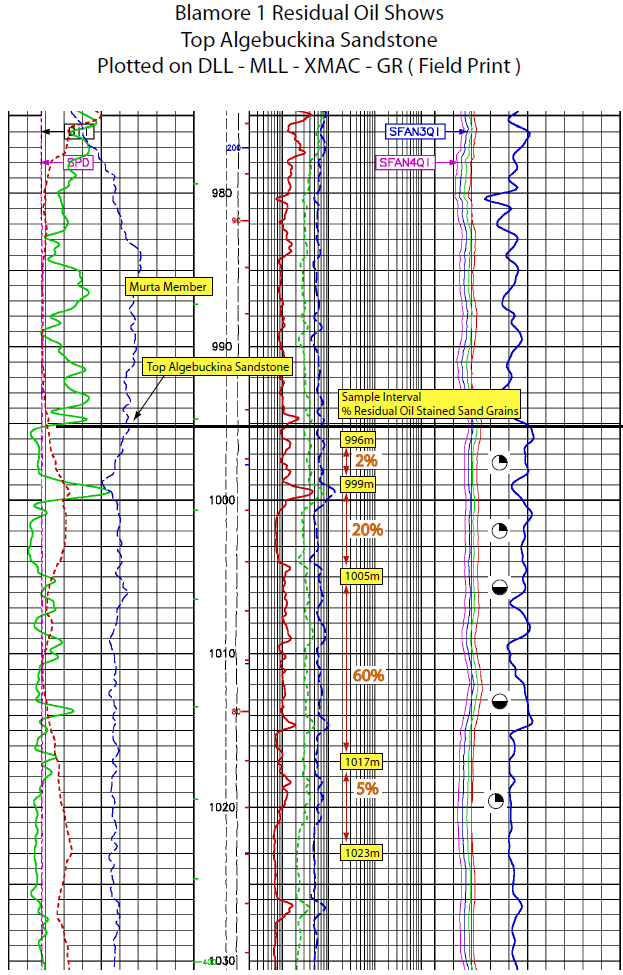
Excerpt from Blamore 1 Well Completion Report
Extent of the Algebuckina Sandstone reservoir in the Poolowanna Trough region
The Cadna-owie Formation directly overlies the Algebuckina Sandstone, and includes the equivalent of the Murta Formation in the Cooper basin region. In the subsurface it consists of a pale grey siltstone with very fine to fine-grained sandstone interbeds and minor carbonaceous claystone (Alexander et al, 2007), with pebbly layers, diamictites and coarse breccia layers around the basin margin containing clasts of quartzite, gneiss and minor igneous lithologies. It is likely to act as a reasonable seal for any hydrocarbons within the Algebuckina, except where sandstones may act as a thief zone, in which case thick marine shales of the Wallumbilla Formation and Bulldog Shale form a regional seal.
In general faulting has not had much of an impact on Eromanga Basin reservoirs other than to set up closures, but this is not necessarily the case in the Poolowanna Trough region, where intense east-west compression and local wrenching during the Miocene resulted in structural rejuvenation and breach of fault seal. This would explain why only residual hydrocarbons were encountered in the Poolowanna Formation in Poolowanna 1, and minor oil fluorescence was encountered within the Algebuckina Sandstone in Poolowanna 2 and 3 and also in the Cadna-owie and Wallumbilla Formations in Poolowanna 2. It would also explain the presence of hydrocarbon soil anomalies at the surface in Northern Territory (Ambrose et al, 2002).
Extent of the Cadna-owie Formation, hence likely area of sealed Algebuckina Sandstone reservoirs in the Poolowanna Trough region
Oil fluorescence has been encountered in the Algebuckina Sandstone in several wells in the Poolowanna Trough region, with a residual oil column interpreted in Blamore 1.
Three intervals contain suitable material in the Poolowanna Trough region to have acted as potential source rocks for charge of hydrocarbons into the Algebuckina Sandstone:
- the Early Jurassic Lower Poolowanna Formation of the Eromanga Basin,
- the Middle to Late Triassic Peera Peera Formation of the Simpson Basin, and
- the Early Permian Purni Formation of the Pedirka Basin.
Lower Poolowanna Formation, Eromanga Basin
The Poolowanna Formation is considered to have poor potential as a source rock in the Cooper basin area of the Eromanga Basin. However, in the Poolowanna Trough region the middle section of the Poolowanna has much better potential: the Poolowanna 1 Well Completion Report indicated “A 40 foot interval within the Poolowanna Formation offers the best source rock potential of the well. The kerogen from this interval included about 25 % diffuse sapropelic material that is rich in exinite, but also in inertinite.”
The Poolowanna Formation source rocks are primarily at the top of the Lower Poolowanna, and so are most likely to be the source for any hydrocarbon accumulations within the Poolowanna due to proximity of the reservoir to the source material. Coals and coal-related lithologies are volumetrically important in the sequence, with maceral composition ranging from vitrinite and vitrinite-rich clarite through a range of trimacerites to durite (Radke, 2009). Inertinite is dominant in dispersed organic matter (DOM) but vitrinite is also abundant. At Poeppels Corner 1, woody herbaceous DOM is rich in exinite. The coals have good to excellent source richness with total organic carbon (TOC) up to 15%, possess good oil generative potential, and have reached peak maturity of 0.9 % Ro in the Poolowanna Trough.
Maturity of the Lower Poolowanna Formation in the Poolowanna Trough region
Peera Peera Formation, Simpson Basin
The Triassic Peera Peera Formation offers fair to good source potential. The Poolowanna 1 Well Completion Report indicated “The uppermost 60 feet of this section consists of black, silty, very organic rich shale, and appears to be an excellent source rock”, and that the formation “appears to be less prospective for liquid hydrocarbons than the Lower Jurassic section, although higher yields of kerogen have been attained in the upper part of the Peera Peera Formation.” The WCR also noted “A large sonic travel time shift (18 microseconds per foot, maximum) indicates the high organic content of this silty shale, which seems to be the main source of hydrocarbons in the area.”
The Peera Peera is rich in Type III kerogen organic matter (TOC around 4-5% although up to 18% in places). Ambrose et al (2007) reported Hydrocarbon Index of 100-200 with yield of 5-11kg/tonne in Macumba 1 (1977), suggesting a source for mixed gas and liquids, which is consistent with the gas flowed to surface from the Peera Peera in Poolowanna 1, albeit at a rate too small to measure. Radke (2009) noted that generally the DOM is higher towards the top of the unit and inertinite is dominant, and that much of the source potential of this unit lies in its abundant coals which have comparable macerals to those in the overlying Poolowanna Formation. He stated that the formation appears to be predominantly gas-prone but with potential for a modest oil yield.
Maturity of the Peera Peera Formation source rocks in the Simpson Basin
Purni Formation, Pedirka Basin
The Early Permian Purni Formation in the Pedirka Basin is the equivalent of the Patchawarra Formation, which is the source for much of the gas and oil discovered in the Cooper and Eromanga Basins. It contains the richest source rocks in the Pedirka Basin-Poolowanna Trough area, with extensive coal-rich organic shale which appears to be both oil and gas-prone. It contains up to 4% dispersed organic matter, with vitrinite and exinite macerals present in moderate abundance. Data from Dalmatia 1 and Mt Hammersley 1 indicate poor to good source potential for oil in the Purni Formation.
Radke (2009) reported both the upper and lower members of the Purni Formation as having good to excellent source rock potential They consist of alternating shale, coal and siltstones deposited in lacustrine, swamp and floodplain settings, with the coals being the richest source rocks, comprising predominantly vitrinite and inertinite, with exinite generally less than 5% (but up to 20%). DOM in carbonaceous shales is generally poor. In the eastern Pedirka, Purni Formation sediments contain both H–rich exinite and vitrinite, and H-poor vitrinite rich source rocks
2008 drilling in the Northern Territory by Central Petroleum established extremely thick coal accumulations away from structural highs, with cumulative thicknesses exceeding 100m for individual seams thicker than 2m. The isopach of the Purni Formation indicates over 660m of section in the Eringa Trough in the Northern Territory.
Algebuckina Sandstone reservoirs directly overlie Permian Purni Formation source rocks in parts of the Poolowanna Trough region. Therefore, it is highly likely that there would have been direct migration of hydrocarbons from the mature Purni Formation source rocks into the Algebuckina Sandstone in these areas.
Maturity of the Purni Formation source rocks in the Pedirka Basin
Thickness of the Purni Formation in the Pedirka Basin
Source rock maturity
Onset of oil generation (Ro=0.5%) would generally be expected with burial at 1500m, and peak oil generation (Ro=0.7%) at 2200m (Radke, 2009), although of course this depends upon the types of organic matter present and the local geothermal gradient. Gas generation is expected from 0.6% Ro at 1900m.
In much of the Pedirka Basin geothermal gradients are low and so sediments may not have generated significant quantities of hydrocarbons, but the Early Jurassic (Poolowanna) and Permo-Triassic sequences have reached the main oil generative window (Ro 0.7-0.9%) over large portions of the Pedirka Basin and Poolowanna Trough.
Basin modelling in the Poolowanna Trough by Ambrose et al (2007) suggested that early onset of oil generation commenced from the Peera Peera Formation in the Early Cretaceous around 135Ma, suggesting that this may have occurred potentially earlier from the Purni Formation in the eastern Pedirka Basin. Peak generation and expulsion from all source rocks occurred primarily during the early part of the Late Cretaceous(100-90Ma) following significant subsidence during the deposition of the Winton Formation.
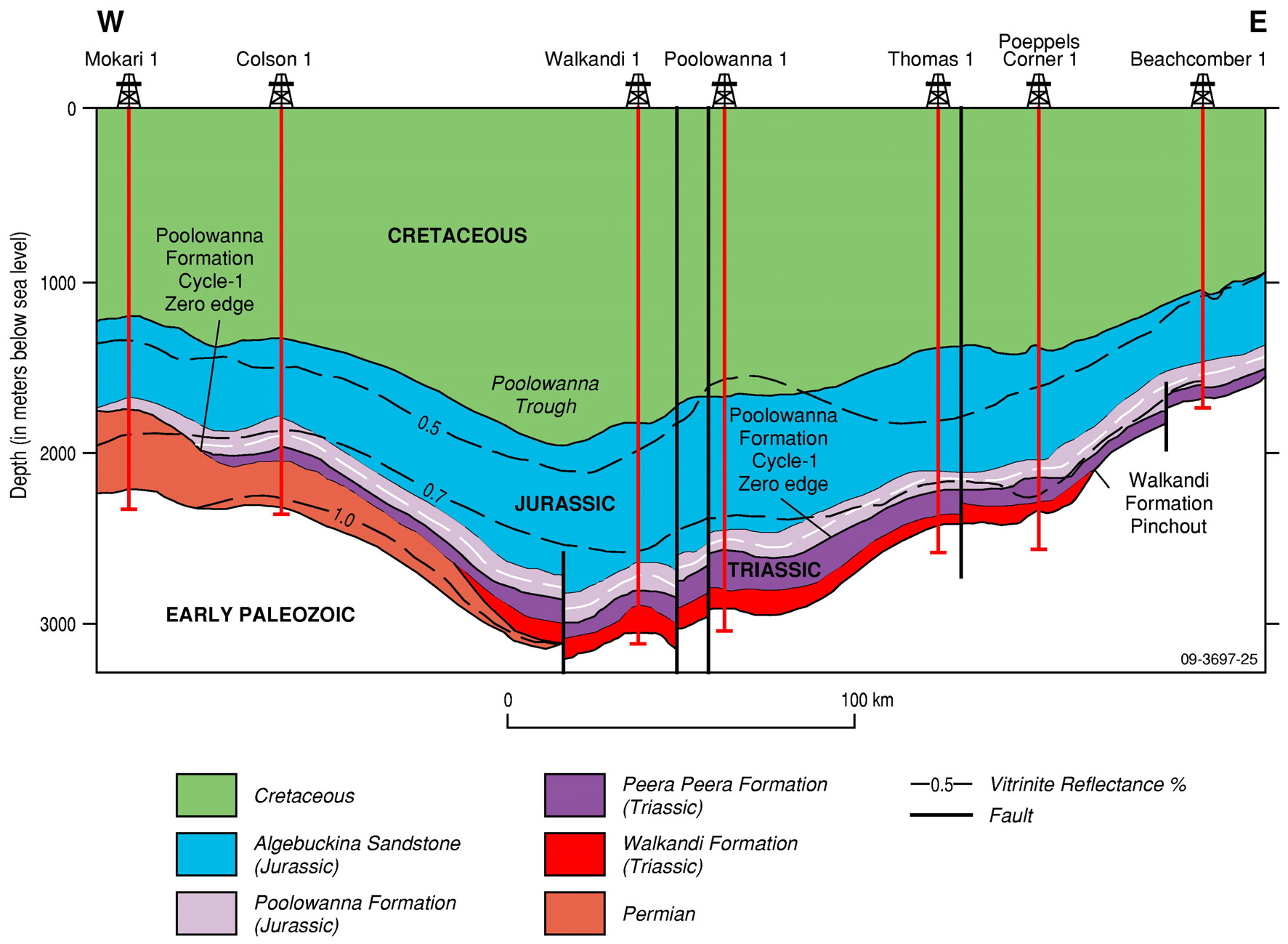
Cross section of the Poolowanna Trough with isoreflectance contours, showing maturity of the sequence up to the basal Jurassic, and a progressively shallower mature sequence to the east (from Radke, 2009, modified from Ambrose et al, 2007).
Three intervals contain suitable material in the Poolowanna Trough region to have acted as potential source rocks for charge of hydrocarbons into the Algebuckina Sandstone:
- Direct charge from Lower Poolowanna source rocks into directly overlying Upper Poolowanna reservoirs on the western and southern sides of the Poolowanna Trough and thence into the Algebuckina Sandstone as there is insufficient seal at the top of the Poolowanna Formation to prevent upwards migration
- Migration from Peera Peera source rocks into the directly overlying Upper Poolowanna reservoirs on the SW side of the Poolowanna Trough and thence into the Algebuckina Sandstone as there is insufficient seal at the top of the Poolowanna Formation to prevent upwards migration
- Vertical migration from Purni source rocks into the Algebuckina Sandstone either:
- directly into the immediately overlying Algebuckina Sandstone, or
- into the immediately overlying Upper Poolowanna reservoirs and thence into the Algebuckina as there is insufficient seal at the top of the Poolowanna Formation to prevent upwards migration
Minor oil fluorescence was encountered within the Algebuckina Sandstone in Poolowanna 2 and 3, suggesting that there may be suitable migration paths from mature source rocks in the region. However, it is interpreted that in the heart of the Poolowanna Trough seals at the top of the Lower Poolowanna Formation would have been good enough to prevent upwards migration into the Algebuckina Sandstone, and this only occurred when these seals were breached during intense east-west compression and local wrenching during the Miocene. Minor fluorescence was also encountered in the Cadna-owie and Wallumbilla Formations in Poolowanna 2, attesting to the breach of the seal.
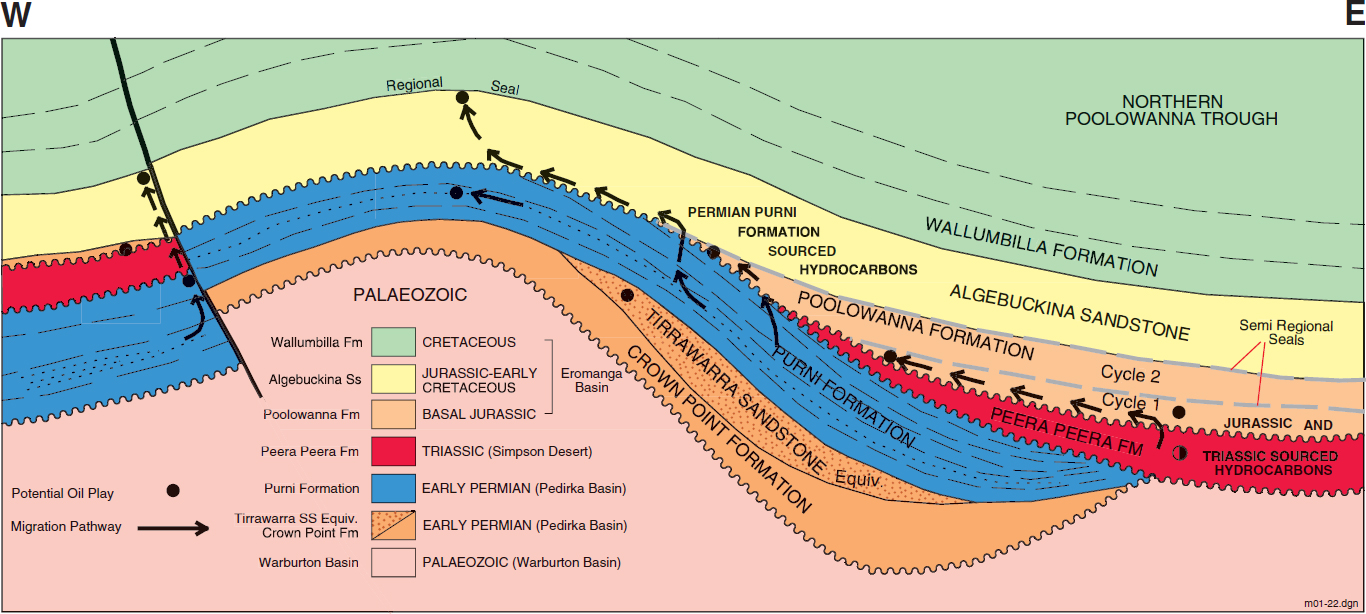
Pedirka, Simpson and Eromanga Basins play types and potential migration pathways (Ambrose et al, 2002)
Up to 20km migration distance from mature source rocks is generally regarded as a reasonable migration distance within porous reservoirs, although Borazjani et al (2019) stated that in the Cooper-Eromanga basins “the migration of expelled oils to Jurassic reservoirs was relatively fast given the short pathway distances of <1 km (fault migration) and ~40 km (carrier bed pathway)”. In this play analysis study 20km migration distances have been used outboard of mature source rock areas, and also 20km migration distance once hydrocarbons have entered the Algebuckina system given the extremely good reservoir quality of the formation.
|
|
| 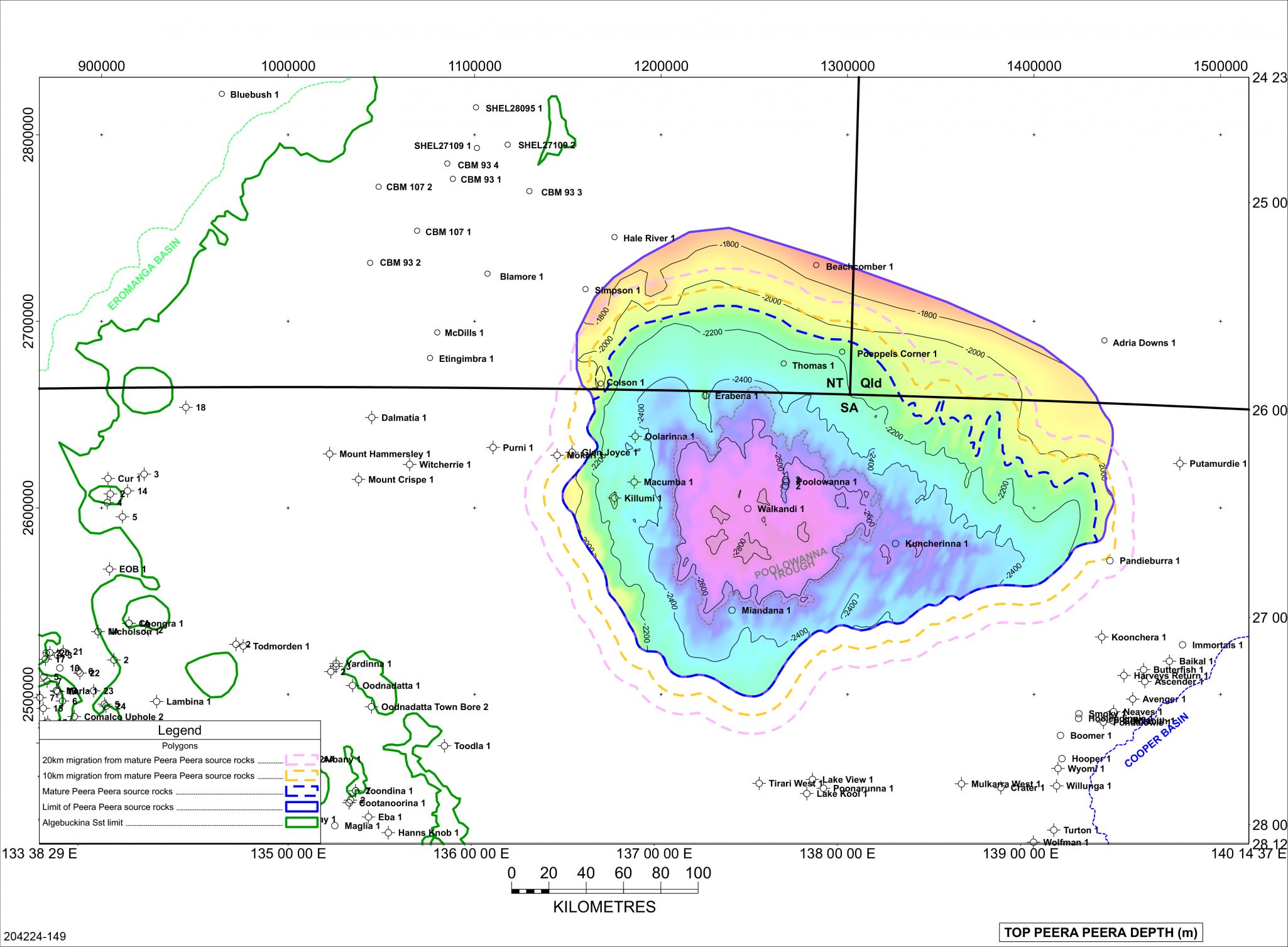 |
|
|
|
|
|
Possible migration extent of hydrocarbons from mature source rocks within the Algebuckina Sandstone |
Trapping mechanisms in the Poolowanna Trough region are likely to be dominated by anticlines with 4-way dip closure over pre-existing, “basement” highs, although onlap and pinch-out traps against Warburton Basin highs are expected along the eastern flank of the Dalhousie-McDills Ridge.
Structures to be investigated must have been in place prior to major generation and expulsion of hydrocarbons, so those that formed during the Cainozoic are less favourable prospects than those formed prior to end of deposition of the Late Cretaceous Winton Formation.
In general faulting has not had much of an impact on Eromanga Basin reservoirs other than to set up closures, but this is not necessarily the case in the Poolowanna Trough region, where intense east-west compression and local wrenching during the Miocene resulted in structural rejuvenation and breach of fault seal.
Therefore, exploration is required of more subtle structures not affected by the reactivation in the Miocene.
In the Cooper-Eromanga Basins a common technique for estimating whether a Present Day structure is likely to have been charged with hydrocarbons or not is to look at the isopach between the top of the Winton Formation and the top of the target formation; this map approximates the target surface structure at time of migration, with thin isopach areas indicating potential structures at time of migration. If there is no top Winton surface mapped in the area of interest the isopach between the top of the Cadna-owie Formation and the target formation is used as a proxy. This technique is applicable in the Poolowanna Trough region with the following caveats:
- The top of the Winton Formation (A seismic horizon) has been mapped in detail only in the South Australian sector of the Eromanga Basin, and not westwards to the edge of the basin, hence the isopach of the top Winton to top Algebuckina interval (a-DN isopach) is not available over the whole of the Poolowanna Trough region
- The interval between the top of the Cadna-owie (C seismic horizon) to top Algebuckina is relatively thin and so may not be representative of likely structure in the region at time of migration
Eromanga Basin structures in South Australia and Queensland are typically not filled with oil to spill; net oil columns are relatively thin compared to the area under closure. This is due to compressive deformation in the early/mid-Tertiary reactivating older structures, and is an important concept given that exploration in the area, and in particular seismic acquisition, has focused on large structures. This may be the reason for Blamore 1 containing residual oil in the Algebuckina Sandstone rather than a live oil column; potentially there could be an anticline filled with oil updip of the well.
It must be borne in mind that the coverage of 2D seismic data within the Poolowanna Trough region is limited compared to that in the Cooper Basin to the south-east. Consequently, structures in reality may be quite different to the way they have been mapped.
|
Structural closures within the Algebuckina Sandstone play area at potential time of migration. |
|  |
Dry hole analysis of the Algebuckina Sandstone
Wells in the Poolowanna Trough region have been reviewed with the latest seismic grids available to DEM. Further seismic data and/or mapping may revise the current interpretations and help determine if some of the structures drilled are valid or not.
1. Wells within approximate Algebuckina play extent drilled on apparently valid closures using existing 2D seismic coverage:
SA:
- Dalmatia 1 (1988) – no shows in well at all; Algebuckina on Purni
- Drilled on a DN closure with ~50m relief
- Immediately adjacent to a NE-SW-striking fault, so possible seal breach during Miocene reactivation
- Killumi 1 (1985) – only minor fluorescence in the Poolowanna
- Drilled crestally on a DN closure with >20m relief
- No A-DN isopach thin nearby
- Lake View 1 (1988) – no shows at all; Namur Sst on Basement
- Well location on SE edge of approximate Algebuckina play extent
- Apparently drilled crestally on a DN closure with ~80m of relief
- No A-DN isopach thin at well location, although updip of a couple of nearby thins
- Lake Kool 1 (1997) – no shows at all; Namur Sst on Basement
- Drilled on the same greater structure as Lake View 1 although on a separate, smaller crest with ~50m of relief
- Location is outside the approximate Algebuckina play extent, to SW of Lake View 1, possibly in a migration shadow
- Poonarunna 1 (1964) – no shows at all; Algebuckina on Basement
- Drilled on the edge of same greater structure tested by Lake View 1 and Lake Kool 1
- Location is outside the approximate Algebuckina play extent, possibly in a migration shadow
- Macumba 1 (1977) – no shows at all
- Well location on E edge of approximate Algebuckina play extent
- Drilled on DN closure, with ?10m relief updip of well location
- No A-DN isopach thin nearby
- Mount Crispe 1 (1966) – no shows in well at all; Mooga Sst on Permian Crown Point
- Well location close to SW edge of approximate Algebuckina play extent
- DN structure has ~10m of relief, with ~5m updip of well – mapping artefact?
- Mount Hammersley 1 (1987) – no shows in well at all; Algebuckina on Purni
- Drilled close to crestally on a DN closure with ~30m relief
- Immediately adjacent to a NE-SW-striking fault, so possible seal breach during Miocene reactivation
- Tirari West 1 (1989) – no shows in well at all; Algebuckina on Basement
- Drilled close to crestally on a faulted DN closure with slightly more than 10m relief
- A separate culmination on the same greater closure is undrilled
- No A-DN isopach thin nearby
NT:
- Colson 1 (1978) - minor fluorescence in the Poolowanna and Peera Peera
- Drilled on the edge of a DN closure, with >10m updip relief
- Well location right on E edge of approximate Algebuckina play extent
- McDills 1 (1967) – minor gas show in the Wallumbilla
- DN structure has ~90m of relief, with ~30m updip of well
- Immediately adjacent to a NE-SW-striking fault, so possible seal breach during Miocene reactivation
2. Wells within approximate Algebuckina play extent apparently drilled off structure but close to Algebuckina closures:
NT:
- Blamore 1 (2008) – 15m plus residual oil column in Algebuckina, up to 60% staining
- DN closure with ~20m relief updip of well location
- Immediately adjacent to a NE-SW-striking fault, so possible seal breach during Miocene reactivation
- Etingimbra 1 (1981) – no shows in well at all
- DN structure has ~100m of relief, with ~50m updip of well
- Immediately adjacent to a NE-SW-striking fault, so possible seal breach during Miocene reactivation
- Large thin on C-DN isopach immediately to the W
3. Wells within approximate Algebuckina play extent with no shows in Algebuckina, apparently drilled off-structure using existing 2D seismic coverage:
SA: Witcherrie 1 (1963), Purni 1 (1963/4), Mokari 1 (1966), Glen Joyce 1 (1985)
NT: Hale River 1 (1966), CBM 93 1 (2008), Simpson 1 (2008)
4. Wells outside approximate Algebuckina play extent apparently drilled on valid closures using existing 2D seismic coverage:
SA well on structure which is within approximate Algebuckina play extent:
- Crater 1(1993) – very minor gas show in Toolebuc and upper Wallumbilla (WCR)
- Gas show up to 14 units over background of 2-3 units, not associated with any potential reservoirs
- Drilled on edge of a DN closure with ~100m relief
- Northern end of closure is within approximate Algebuckina play extent
- Closure coincides with a A-DN isopach thin
SA wells within area of seals within Lower Poolowanna, Triassic and Permian so likely no charge into Algebuckina:
- Erabena 1 (1981) – minor fluorescence in Poolowanna and Peera Peera
- Drilled crestally on a DN closure with at least 30m of anticlinal relief, and significantly more fault-related closure
- Immediately adjacent to a N-S-striking fault, so possible seal breach during Miocene reactivation
- Kooncherra 1 (1984)
- Crestal on a very large DN closure with ~70m of relief
- Kuncherinna 1 (1981/2) – trace oil in Poolowanna, minor fluorescence in Peera Peera
- Crestal on a DN closure with ~20m of relief
- Updip of a large A-DN isopach thin
- Miandana 1 (1985) – no shows in Algebuckina, minor fluorescence in Poolowanna
- Crestal on a DN closure with ~20m of relief
- Updip of a small A-DN isopach thin
- Oolarinna 1 (1985) – minor fluorescence in Poolowanna, gas-cut water in Peera Peera
- Drilled crestally on an apparently valid low relief DN closure
- No A-DN isopach thin nearby
- Poolowanna field
- Poolowanna 1 (1977) – recovered oil and gas from Poolowanna and Peera Peera
- Poolowanna 2 (1985) – minor fluorescence in Wallumbilla, Cadna-owie, Algebuckina, Poolowanna & Peera Peera
- Poolowanna 3 (1989) – minor fluorescence in Algebuckina, Poolowanna and Peera Peera
- Wells drilled on faulted DN closure with >40m relief
- None of the wells drilled crestally
- 5-10m of mapped anticlinal closure updip of shallowest well, Poolowanna 2?
- Fluorescence in Algebuckina likely due to breach of seal for the Poolowanna/Peer Peera accumulations following intense east-west compression and local wrenching during the Miocene, probably allowing migration up the fault plane
- Walkandi 1 (1981) –oil shows in Poolowanna, Peera Peera and Walkandi
- Drilled on a large relatively low relief DN closure, with ~10m of closure updip of well location
NT wells within area of seals within Lower Poolowanna, Triassic and Permian so likely no charge into Algebuckina:
- Beachcomber 1 (1988) – minor fluorescence in coals in Cadna-owie, Algebuckina and Poolowanna
- Drilled immediately downdip of a small DN closure with ~10m relief
- Thomas 1 (1981) – residual oil in Poolowanna
- Drilled on DN closure with ~30m relief
5. Wells outside approximate Algebuckina play extent apparently drilled off structure but with oil shows:
- Poeppels Corner 1(1984) – minor fluorescence in Algebuckina, Poolowanna & Peera Peera
- Odd DN structure around well - either a seismic mistie or a fault
- Fluorescence in Algebuckina possibly due to breach of seal for a Jurassic or Triassic accumulation following intense east-west compression and local wrenching during the Miocene, allowing migration up the fault plane
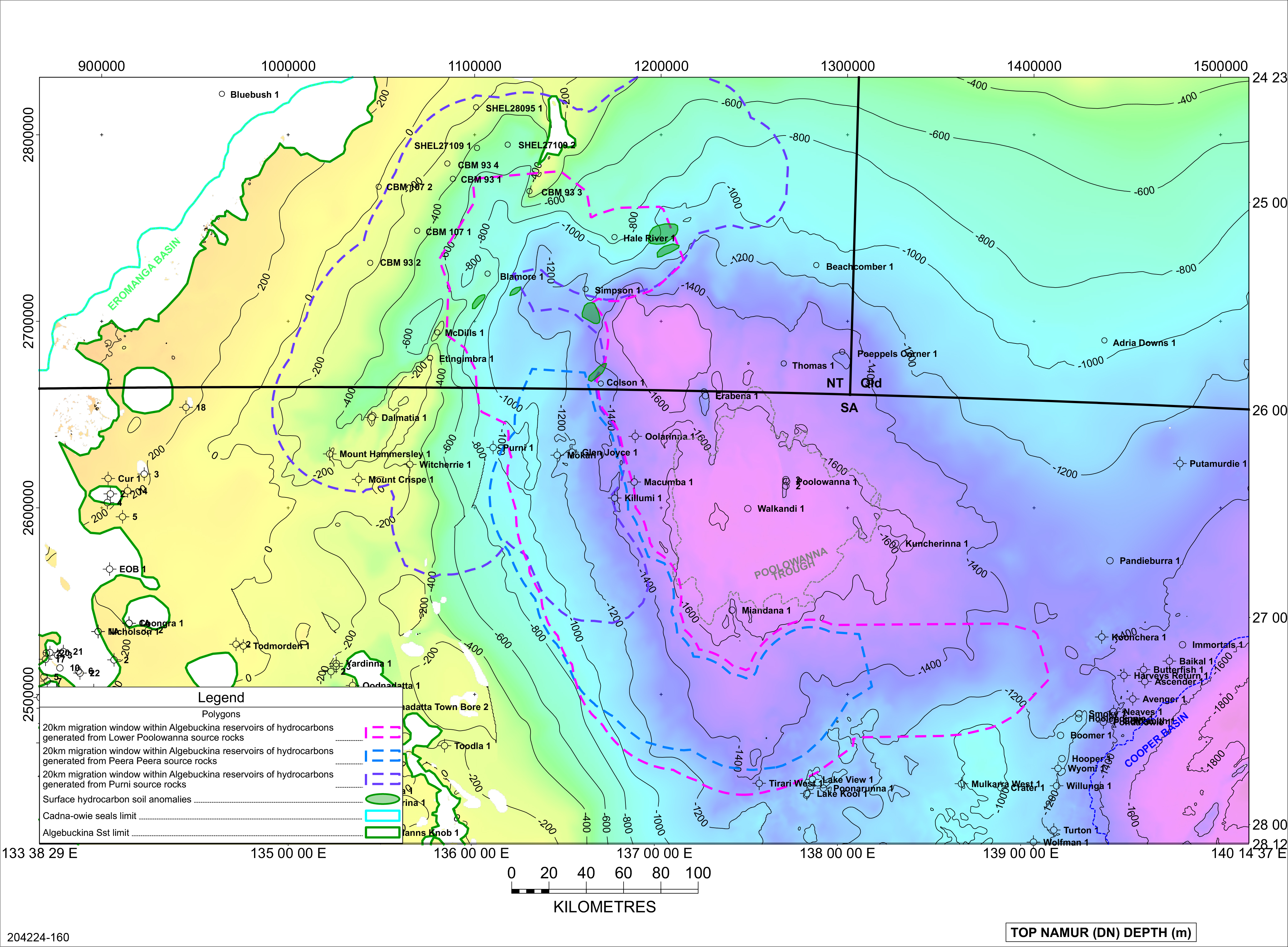
Play elements for the Algebuckina Sandstone in the Poolowanna Trough region
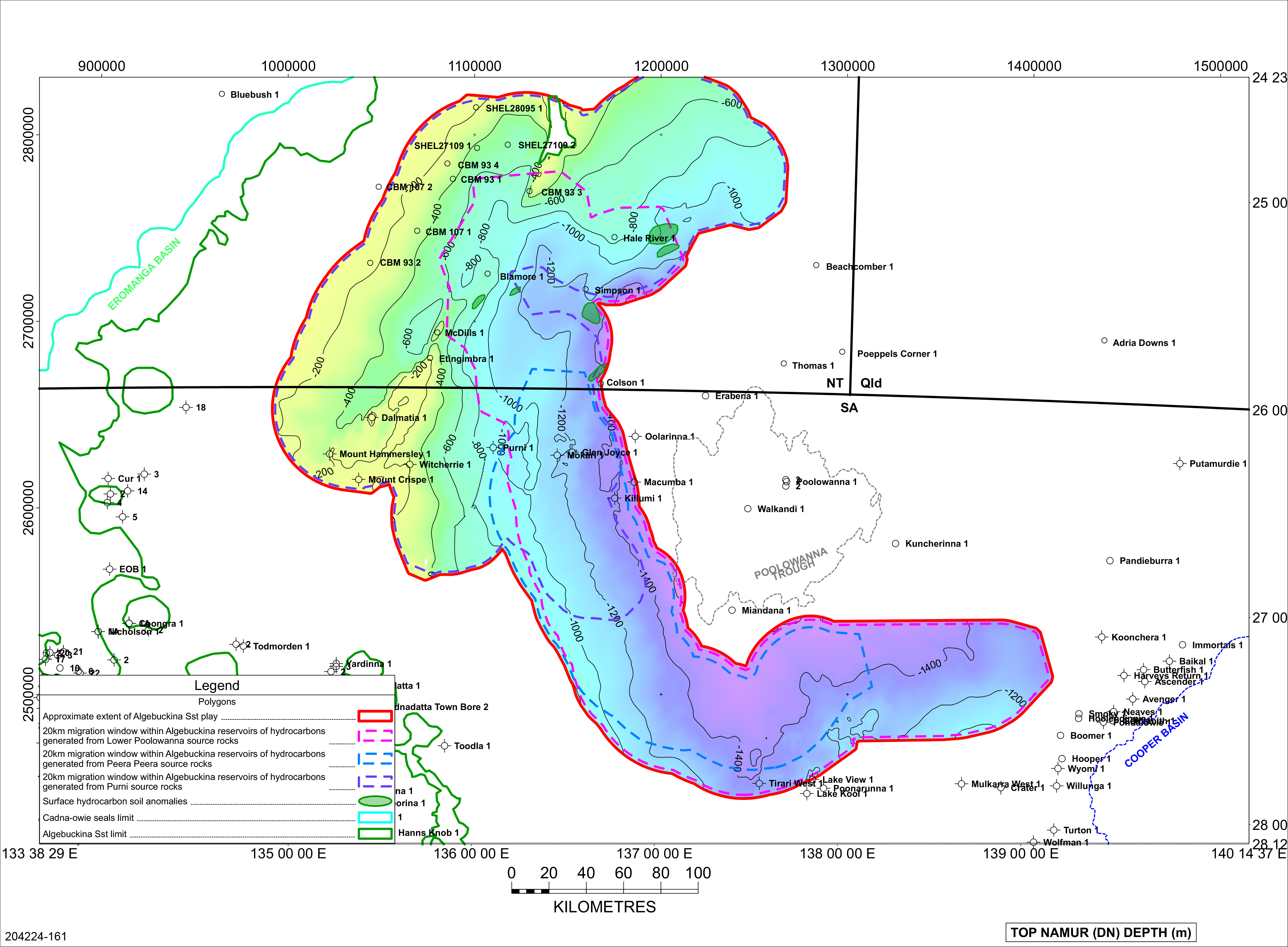
Approximate extent of the Algebuckina Sandstone play in the Poolowanna Trough region
| Proven production from the Algebuckina: | None |
| Number of producing wells at 31 March 2021: | None |
| Total production at 31 March 2021: | None |
| Hydrocarbon flow rates: | No hydrocarbon flows within the Pedirka Basin-Poolowanna Trough region. Water flowed at 1150BPD in Lake View 1. |
Undiscovered recoverable oil resources of the western Eromanga Basin (ERD estimate June 2006, Morton and Hill, 2007)
| UNDISCOVERED POTENTIAL 106 kL (mmbbl) | ||||||
PLAY | Probability that the ultimate potential will exceed the stated value: | |||||
| 90% | 50% | 10% | ||||
Namur-Algebuckina | 1.0 | (6.3) | 4.1 | (25.8) | 13.0 | (81.8) |
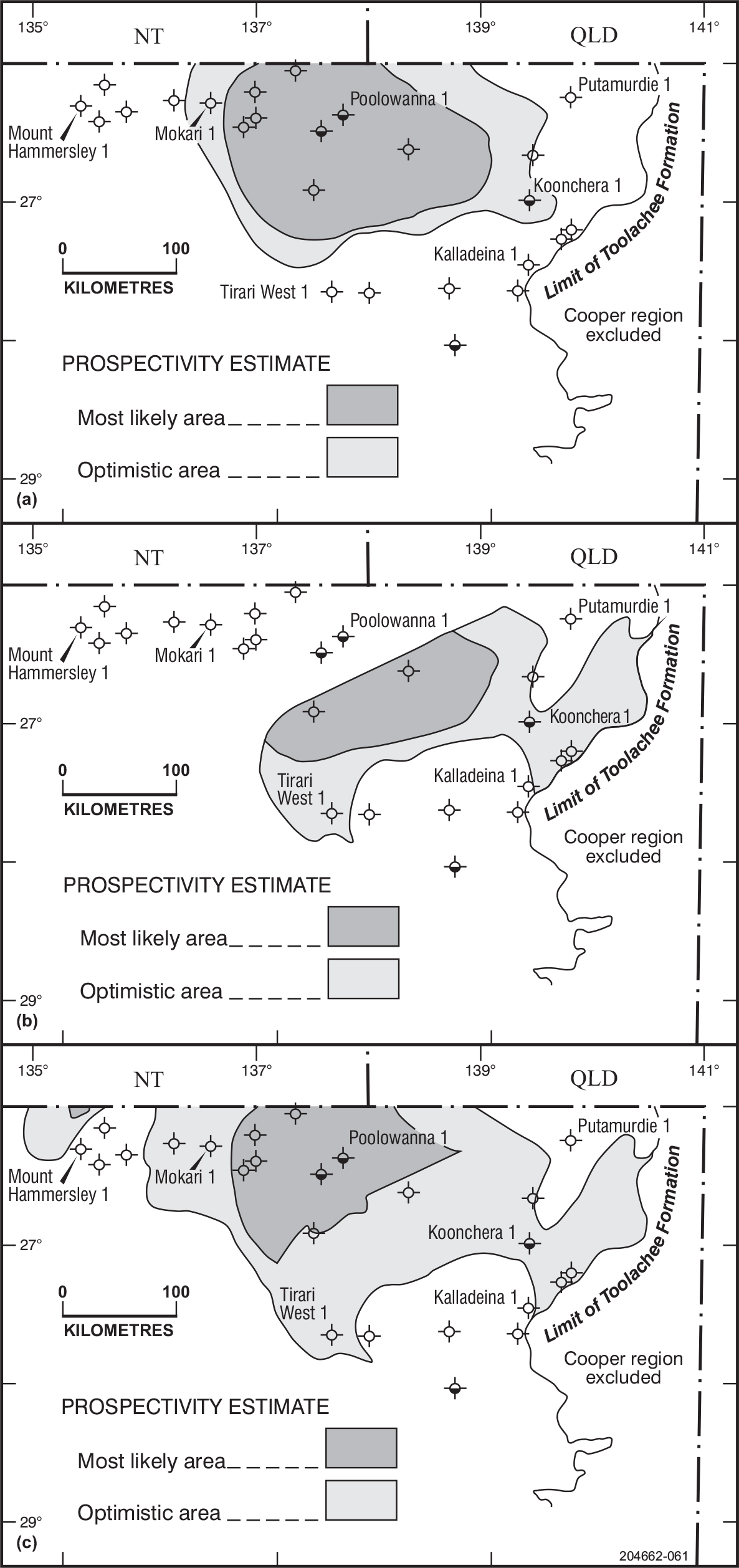
Prospectivity of the western Eromanga Basin: (a) Poolowanna Formation; (b) Hutton Sandstone; (c) Namur–Algebuckina Sandstones
Alexander, EM, and Jensen-Schmidt, B, 1995: Eringa Trough exploration opportunity; South Australia. Department of Mines and Energy. Report Book, 95/00036.
Alexander, EM and Boult, PB, 2007. Reservoirs and seals; Chapter 11 in Cotton, TB, Scardigno, MF, and Hibburt, JE, eds: The Petroleum Geology of South Australia. Vol. 2: Eromanga Basin. 2nd edn; South Australia; Department of Primary Industries and Resources. Petroleum Geology of South Australia Series.
Alexander EM, Sansome, A and Cotton, TB, 2007. Lithostratigraphy and environments of deposition; Chapter 5 in Cotton, TB, Scardigno, MF, and Hibburt, JE, eds: The Petroleum Geology of South Australia. Vol. 2: Eromanga Basin. Second edition; South Australia Department of Primary Industries and Resources. Petroleum Geology of South Australia Series.
Ambrose, GJ, Liu, K, Deighton, I, Eadington, PJ, and Boreham, CJ, 2002: New petroleum models in the Pedirka Basin, Northern Territory, Australia; The APPEA Journal, 42(1): 259-286.
Ambrose, G., Scardigno, M., and Hill, A.J., 2007: Petroleum geology of Middle-Late Triassic and Early Jurassic sequences in the Simpson Basin and northern Eromanga Basin of Central Australia; The APPEA Journal, 47(1): 125-142.
Borazjani, S, Kulikowski, D, Amrouch, K and Bedrikovetsky, 2019: Composition changes of hydrocarbons during secondary petroleum migration (case study in Cooper Basin, Australia); Geosciences, 9(2), 78
Carne, GE and Alexander, EM, 1997: Eromanga Basin prospects inventory, Blocks ER97-A to C, Exploration opportunity; South Australia. Department of Mines and Energy Resources. Report Book, 97/00021.
Giuliano MF, 1988. The geology and hydrocarbon potential of the Pedirka Basin. University of Adelaide. National Centre for Petroleum Geology and Geophysics. BSc (Hons) thesis (unpublished).
Morton, JGG and Hill, AJ, 2007. Undiscovered Petroleum Resources. Chapter 14 Cotton, TB, Scardigno, MF, and Hibburt, JE, eds: The Petroleum Geology of South Australia. Vol. 2: Eromanga Basin. Second edition; South Australia Department of Primary Industries and Resources. Petroleum Geology of South Australia Series.
Radke, B., 2009: Hydrocarbon & Geothermal Prospectivity of Sedimentary Basins in Central Australia. Record 2009/25. Geoscience Australia, Canberra.
Strong, P. 2023. Play Analysis in the Pedirka Basin-Poolowanna Trough region. Presented at NTGS Geoscience Gabfest, Darwin, Northern Territory, 24 February 2023.


